Furuno USA 9ZWRTR088B Transceiver for Radar model FR-8045 User Manual
Furuno USA Inc Transceiver for Radar model FR-8045
Contents
User Manual II Part 3

2-1
2. DESCRIPTION OF RADAR
2.1 General
2.1.1 Minimum and maximum ranges
Minimum range
The minimum range is defined by the shortest distance at which, using a scale of
0.0625 or 0.125 nm, a target that has an echoing area of 10 m2 is shown separate from
the point that shows the antenna position.
The minimum range depends on the pulselength, antenna height, and signal process-
ing (like main bang suppression and digital quantization). Use a shorter range scale
as far as it gives favorable definition or clarity of picture.
Maximum range
The maximum detection range, Rmax, changes depending on the height of the anten-
na, the height of the target above the sea, the size, shape and material of the target,
and the atmospheric conditions.
Under normal atmospheric conditions, the maximum range is equal or a little shorter
than the optical horizon. The radar horizon is longer than the optical one by approxi-
mately 6%, because of the diffraction property of the radar signal. The Rmax is shown
in the following formula.
If the height of the antenna is 9 m and the height of the target is 16 m, the maximum
radar range is;
Note: The detection range is reduced by any precipitation (which absorbs the radar
signal).
R
max
= 2.2 x ( h1 + h2)
where R
max
: radar horizon (nautical miles)
h1: antenna height (m)
h2: target height (m)
Radar horizon
Optical horizon
Rmax = 2.2 x ( 9 + 16) = 2.2 x (3 + 4) = 15.4 nm
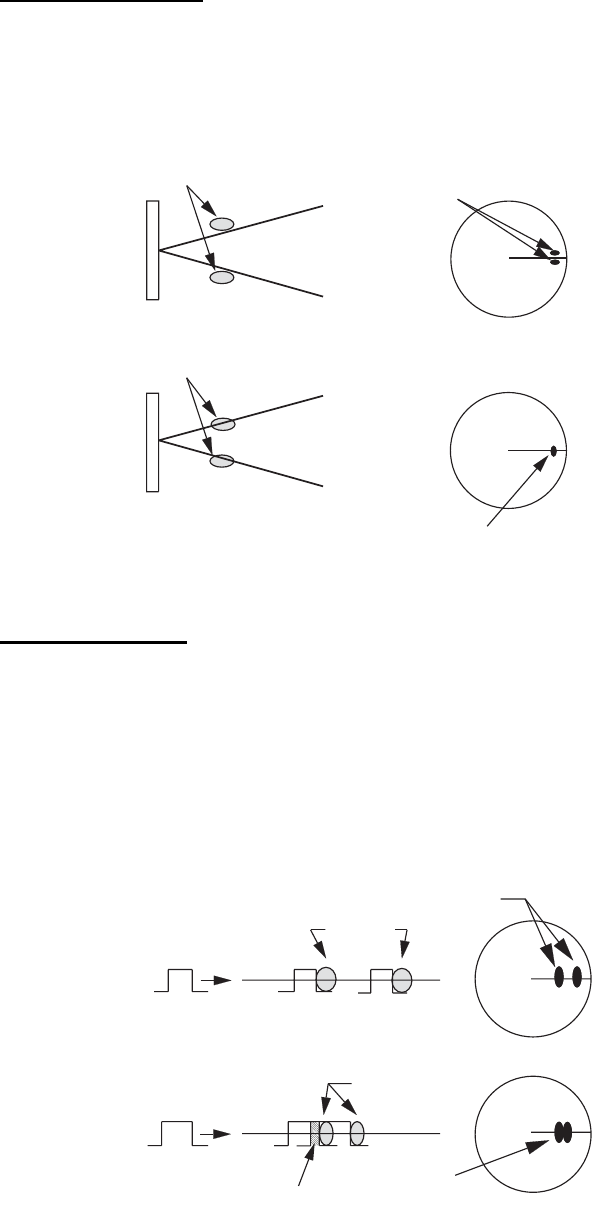
2. DESCRIPTION OF RADAR
2-2
2.1.2 Radar resolution
The bearing resolution and range resolution are important in radar resolution.
Bearing resolution
The bearing resolution is the ability of the radar to display the echoes received from
two targets at the same range as the separate echoes. The bearing resolution is pro-
portional to the antenna length and the wavelength.
Bearing resolution
Range resolution
The range resolution is the ability to display the echoes received from two targets on
the same bearing as separate echoes. The range resolution is calculated by only
pulselength.
The test targets used to calculate the range and bearing resolution are radar reflectors
that have an echoing area of 10 m2.
Range resolution
Targets
Targets
Horizontal beam width
Horizontal beam width
Separate
target
echoes
Overlapped
target echoes
Separate
target echoes
Overlapped
target echoes
Targets
Targets
Overlapping
Transmission
pulse
Transmission
pulse
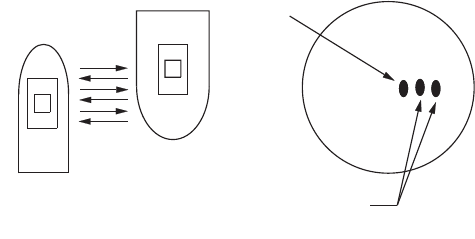
2. DESCRIPTION OF RADAR
2-3
2.1.3 Bearing accuracy
One of the most important features of the radar is how accurately the bearing of a tar-
get can be measured. The accuracy of bearing measurement depends on the narrow-
ness of the radar beam. The bearing taken is relative to the heading of the ship.
Correct adjustment of the heading line at installation is important to get accurate bear-
ings. To minimize the error when you measure the bearing of a target, put the target
echo at the extreme position on the screen by selecting a suitable range.
2.1.4 Range measurement
Measurement of the range to a target is important function of the radar. There are
three methods to measure range: the fixed range rings, the Variable Range Marker
(VRM), and the cursor (if the cursor is set to measure range and bearing). The fixed
range rings appear on the screen with a given interval and provide a rough estimate
of the range to a target. The diameter of VRM is increased or decreased so that the
marker touches the inner edge of the target (see paragraph 1.15.2). The VRM is a
more accurate range measurement than the fixed range rings. For cursor, see
section 1.13.
2.2 False Echoes
The echo signals can appear on the screen at positions where there is no target or
disappear when there are targets. These false echoes are shown below.
2.2.1 Multiple echoes
Multiple echoes occur when a transmitted pulse returns from a solid object like a large
ship, bridge, or breakwater. A second, a third or more echoes can be seen on the dis-
play at double, triple or other multiples of the actual range of the target as shown be-
low. You can reduce and remove the multiple reflection echoes with the A/C SEA
control.
Multiple echoes
Your ship
Target
True
echo
Multiple
echo
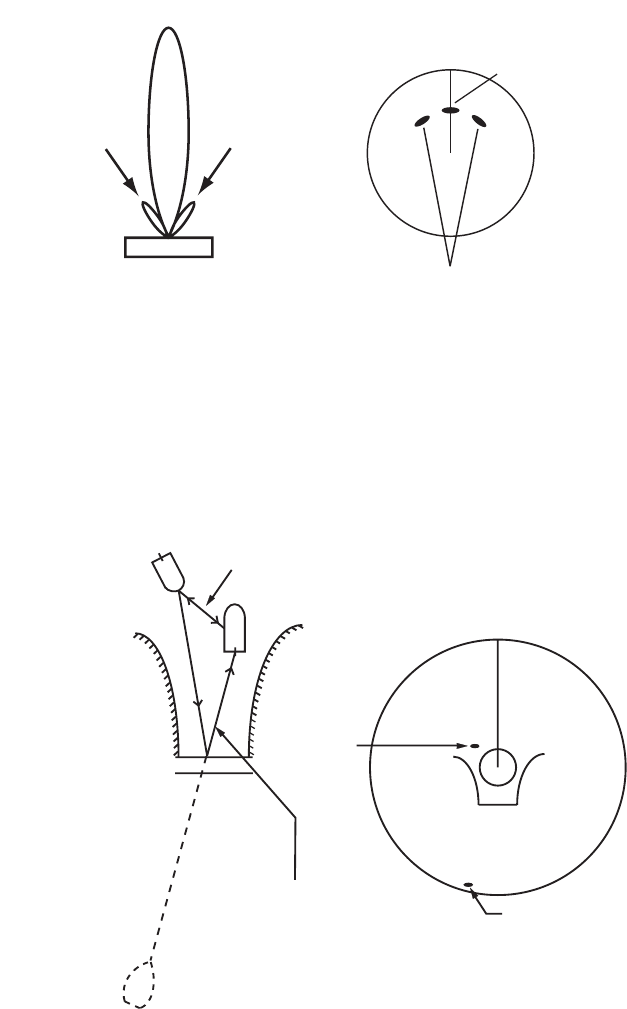
2. DESCRIPTION OF RADAR
2-4
2.2.2 Sidelobe echoes
When the radar pulse is transmitted, some radiation escapes on each side of the
beam, called "sidelobes”. If a target is where a target can be detected by the sidelobes
as well as the mainlobe, the side echoes can be shown on both sides of the true echo
at the same range. Sidelobes show normally only on short ranges and from strong tar-
gets. You can reduce the sidelobes with the A/C SEA control.
2.2.3 Virtual image
A large target close your ship can appear at two positions on the screen. One of them
is the true echo reflected by the target. The other is a false echo which is caused by
the mirror effect of a large object on or close your ship as shown in the following figure.
If your ship comes near a large metal bridge, for example, a false echo can temporarily
appear on the screen.
True target
Mainlobe (beam)
Antenna
Sidelobe
False echoes by sidelobes
Sidelobe
True
echo
False
echo
Your ship
Target ship
Mirror image
of target ship
Bridge
Route for direct reflection
Route for
indirect reflection
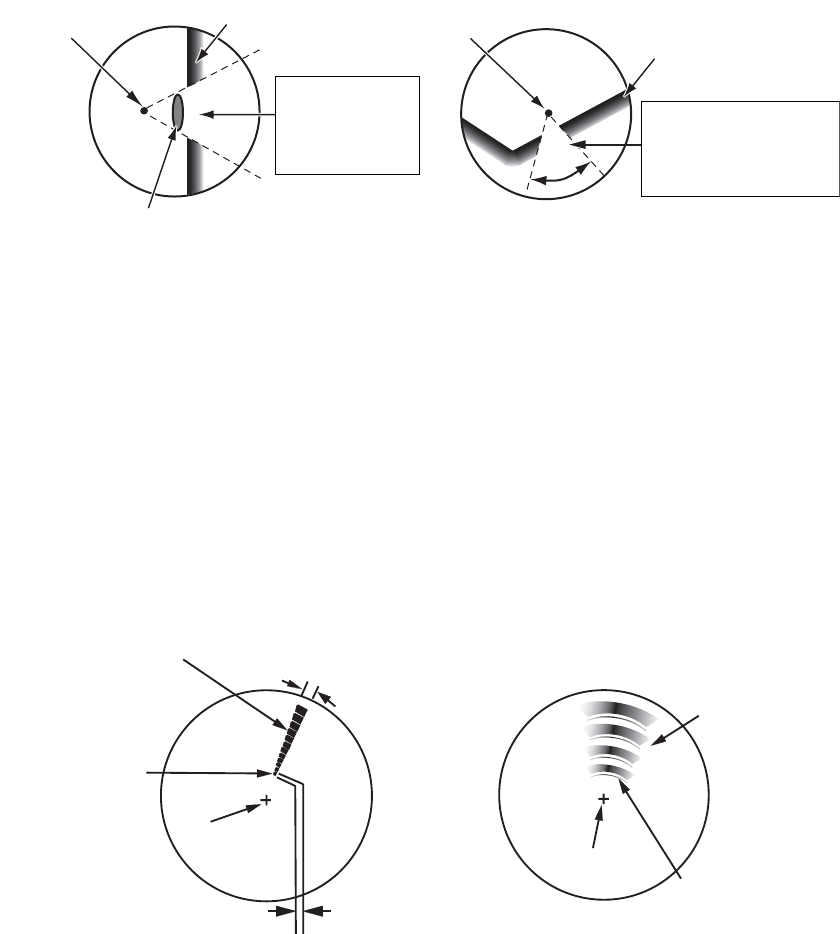
2. DESCRIPTION OF RADAR
2-5
2.2.4 Shadow sector
Funnels, stacks, masts, or derricks near the antenna interrupt the radar beam, and a
non-detecting sector can occur. Radar can not detect targets within this sector.
2.3 SART (Search and Rescue Transponder)
2.3.1 SART description
A Search and Rescue Transponder (SART) responds to any X-band (3 cm) radar with-
in a range of approximately 8 nm. Each radar pulse received causes the SART to
transmit a response which is swept continuously across the complete radar frequency
band.
Wharf and its echo
Large ship Size of blind sector depends
on size of obstruction and range.
Radar position Radar position
Wharf and its echo
Shadow sector occurs
because obstruction
(like mast) is in path
of radar beam.
Shadow sector
occurs because
wharf is hidden
behind ship.
Radar antenna
beamwidth
Screen A: When SART is distant Screen B: When SART is close
Echo from SART
Position of
SART
Your ship
position Your ship
position
SART mark
length
24 NM 1.5 NM
Position of
SART
Echo from
SART
Lines of 12 dots are displayed in
concentric arcs.

2. DESCRIPTION OF RADAR
2-6
2.3.2 General remarks on receiving SART
SART range errors
When the SART is at a range greater than approximately 1 nm, the first dot is dis-
played at 0.64 nm past the true position of the SART. When the range closes so that
the fast-sweep responses are also seen, the first range echoes are displayed at 150
m past the true position.
Range scale
When you find the SART position, do as follows:
1. Use the RANGE key to set the range scale to 6 nm or 12 nm.
2. Turn off [A/C Auto].
3. Turn off [Int Rejector].
SART display
To display only the SART echo clearly on the radar screen, reduce the tuning on man-
ual mode. The normal radar echoes get weak, but the SART echoes remain. Your ship
comes near the SART, the arc for the SART display becomes larger. Most of the radar
screen becomes fuzzy. Adjust the A/C SEA and GAIN controls to display the neces-
sary screen.
2.4 RACON
The RACON is a RAdar beaCON which sends radar-receivable signals in the radar
frequency spectrum (X- or S-band). There are several signal formats; in general, the
RACON signal appears on the radar screen as an echo in the shape of a rectangle
originating at a point just past the position of the radar beacon. It has a Morse coded
pattern. Note that the position on the radar display is not accurate.
Echo description
Your ship position
RACON signal
RACON station
Echoes on the radar screen

3-1
3. ARPA OPERATION
The Automatic Radar Plotter ARP-11 (option) manually or automatically acquires and
tracks ten targets. When a target is acquired automatically or manually, a target is au-
tomatically tracked within 0.1 to 16 nm.
3.1 Precautions for Use
3.2 Controls for Use with ARPA
ENTER: Acquire the cursor-selected target. Display data for tracked target (in the data
box at the bottom of the screen).
CANCEL/HL OFF: Remove data of cursor-selected tracked target from the data box.
Stop tracking the cursor-selected target (when its data is not displayed in the data
box).
MENU: Access the [Target] and [ARPA] menus for ARPA operations.
CursorPad: Select a target to acquire (or cancel the tracking). Select a target to show
(or remove) target data.
Do not depend on one navigation device
for the navigation of the ship. The
navigator must check all aids available
to confirm position. Electronic aids are
not a replacement for basic navigation
principles and common sense.
· The ARPA automatically tracks an
automatically or manually acquired radar
target and calculates its course and
speed, indicating them by a vector. Since
the data from the auto plotter depend on
the selected radar targets, the radar must
be optimally tuned for use with the auto
plotter, to ensure required targets will not
be lost or unnecessary targets like sea
returns and noise will not be acquired
and tracked.
· A target is not always a landmass, reef,
ship, but can be returns from the sea
surface and clutter. As the level of clutter
changes with the environment, the
operator must correctly adjust the A/C
SEA, A/C RAIN and GAIN controls so
that the target echoes do not disappear
from the radar screen.
The plotting accuracy and response of
this ARPA meets IMO standards.
The tracking accuracy is affected by the
following:
· The tracking accuracy is affected by
course change. One to two minutes is
required to restore vectors to full
accuracy after a sudden course change.
(The actual amount depends on
gyrocompass specifications.)
· The amount of tracking delay is inversely
proportional to the relative speed of the
target. Delay is on the order of 15-30
seconds for high relative speed; 30-60
seconds for low relative speed.
The display accuracy is affected by the
following:
· Echo intensity
· Pulse width of radar transmission
· Radar bearing error
· Gyrocompass error
· Course change (your ship or target)
CAUTION
CAUTION
CAUTION
CAUTION

3. ARPA OPERATION
3-2
3.3 ARPA Display On/Off
You can turn the ARPA display on or off. The system continuously tracks ARPA tar-
gets regardless of this setting.
1. Press the MENU key to open the menu.
2. Use S or T to select [ARPA] and press the ENTER key.
3. Use S or T to select [Display] and press the ENTER key.
ARPA Display options
4. Use S or T to select [Off] or [On] then press the ENTER key.
5. Press the MENU key to close the menu.
3.4 How to Acquire and Track the Targets
Ten targets are acquired and tracked manually or automatically.
3.4.1 Manual acquisition
You can acquire a maximum of ten ARPA targets. When the automatic acquisition
([Auto Acquisition] on the [ARPA] menu) is set to on, you can manually acquire a max-
imum of five targets.
1. Use the CursorPad to put the cursor on the target to acquire.
2. Press the ENTER key.
The ARPA target symbol changes over time as shown below. A vector which indicates
the motion direction of the target appears approximately one minute after the acquisi-
tion.
ARPA target symbol
Target number
[River] and [Sea] (Non-IEC system): An acquired target gets the youngest unused
number. When a target is lost and disappears from the number list, the next acquired
target takes the number of that lost target (ie: In a five-target list, if the target 2 is lost,
the next acquired target takes the number of target 2).
[IEC] and [Russian-River] (IEC system): An acquired target gets the youngest un-
used number. When a target is lost and disappears from the number list, the next ac-
quired target takes the next sequential number until reaching a maximum 10. If the
target number reaches a maximum 10, the next acquired target takes the number of
a previously lost target.
Off
On
A
t acquisition 1 min. after
acquisition
3 min. after
acquisition
01 Target number
Vector
01
01
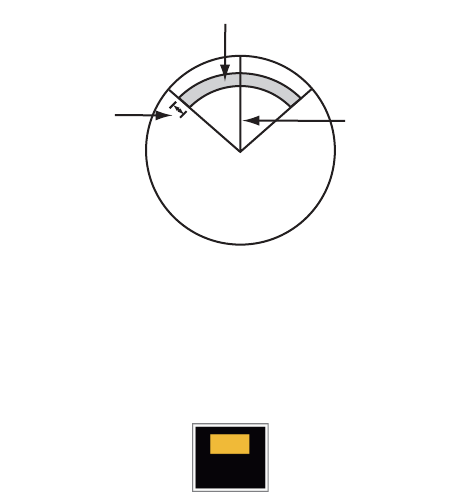
3. ARPA OPERATION
3-3
3.4.2 Automatic acquisition
When you set an automatic-acquisition area, the ARPA can acquire a maximum of five
targets automatically.
The automatic acquisition area is 2.0 to 2.5 nm in range and ±45° on either side of the
heading line in bearing. When you change the automatic acquisition to the manual ac-
quisition, targets tracked in automatic acquisition are continuously tracked.
Automatic acquisition area
1. Press the MENU key to open the menu.
2. Use S or T to select [ARPA] and press the ENTER key.
3. Use S or T to select [Auto Acquisition] and press the ENTER key.
Auto Acquisition options
4. Use S or T to select [On] and press the ENTER key.
5. Press the MENU key to close the menu.
3.5 How to Stop the Tracking of ARPA Target
When ten targets have been acquired, there is no more acquisition, unless targets are
cancelled. If you acquire additional targets, you must cancel one or more separate tar-
gets, or all targets. Use one of the following procedures.
3.5.1 How to stop the tracking of selected targets
1. Use the Cursorpad to put the cursor on the target to cancel the tracking.
2. Press the CANCEL/HL OFF key to cancel the tracking and erase the ARPA sym-
bol. The unit beeps twice and the symbol is erased from the screen.
3.5.2 How to stop the tracking of all targets
1. Press the MENU key to open the menu.
2. Use the CursorPad to put the cursor on the target to cancel the tracking.
3. Use S or T to select [ARPA] and press the ENTER key.
Automatic acquisition area
45° port 45° starboard
2.0 - 2.5 nm Heading line
Off
On
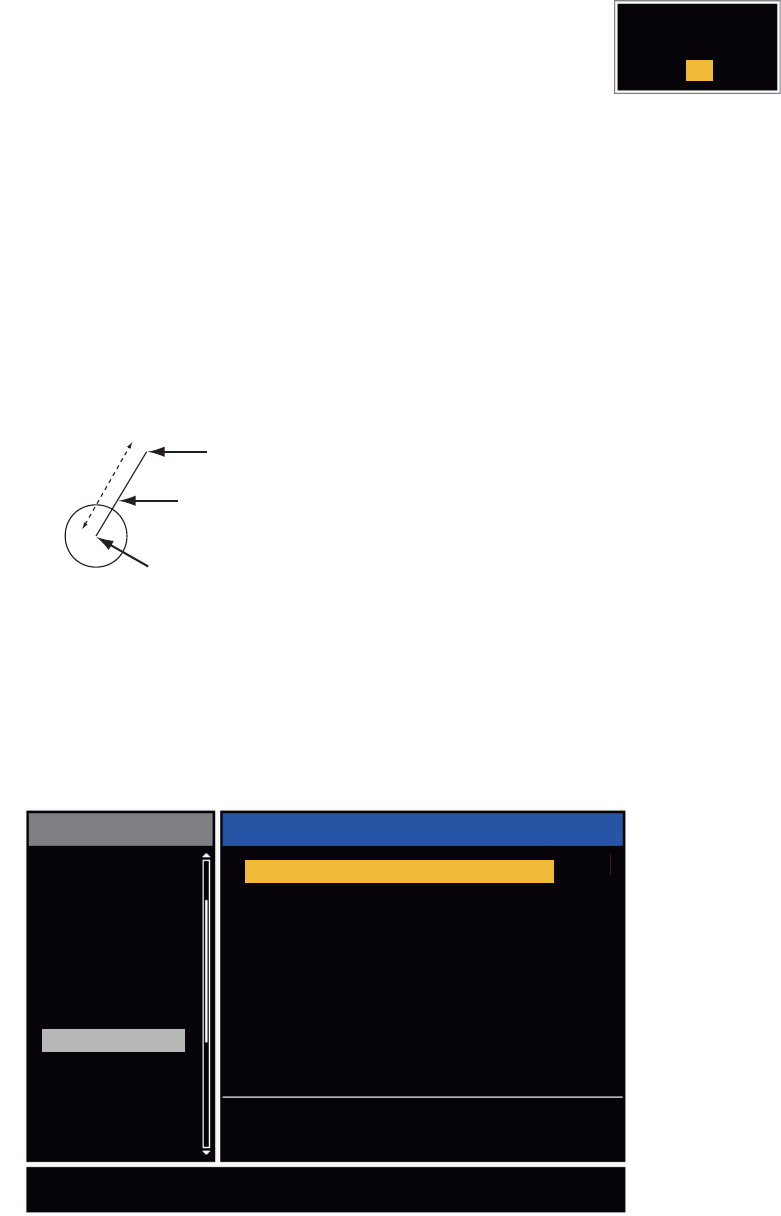
3. ARPA OPERATION
3-4
4. Use S or T to select [All Cancel] and press the ENTER key.
5. Use S to select [Yes] and press the ENTER key. All symbols
are erased from the screen and the long beep sounds.
6. Press the MENU key to close the menu.
3.6 Vector Attributes
3.6.1 What is a vector?
A vector is a line extending from a tracked target. A vector shows speed and course
of the target. The top of a vector shows estimated position of the target after the se-
lected vector time elapses. If you increase the vector length (time), you can evaluate
the risk of collision with any target.
When vector time is 15 minutes
3.6.2 Vector time and vector reference
1. Press the MENU key to open the menu.
2. Use S or T to select [Target] and press the ENTER key.
Target menu
Are your sure ?
Yes
No
Vector
Current position of the target
Vector time
Predicted position of the target in 15 minutes later
Custom 1
Custom 2
Target Trail
Custom 3
Alarm
Target
Tuning
ARPA
Others
AIS
GPS
Menu Target
Vector Reference
History Dots
History Interval
Proximity
: True
: 5
: 1min
: Off
TCPA : 1min
CPA
: Off
Vector Time : 6min
[ENTER]: Enter
[MENU]: Exit
[CANCEL/HL OFF]: Back
Adjusting a vector time to be displayed

3. ARPA OPERATION
3-5
3. UseS or T to select [Vector Time] and press the ENTER key.
Vector Time setting window
4. Use S or T to select time and press the ENTER key.
5. Use S or T to select [Vector Reference] and press the ENTER key.
Vector Reference options
6. Use S or T to select [Relative] or [True] then press the ENTER key. This function
is not activate for [IEC] or [Russian-River] purpose. The mode is set to [True].
[Relative]: Other ships’ vectors are displayed relative to your ship. This mode
helps find the targets on a collision course. If a ship is on a collision course with
your ship, the vector of a ship points toward your ship position.
[True]: Your ship’s and other ships’ vectors are displayed at their true motions.
This mode helps see the differences between moving and stationary targets.
7. Press the MENU key to close the menu.
Note: The functions of the [Target] menu are shared by ARPA and AIS.
3.6.3 Vector of your ship
The vector of your ship is shown as an arrow from your ship position. The vector of
your ship is shown on the following conditions:
• Connect ARP-11 (option)
• Select [True] on the menu item [Vector Reference] on the [Target] menu
• Independent of on/off on the menu item [Display] on the [ARPA] menu
Note: The vector of your ship is shown in the same color as the ARPA symbol color
(see section 3.12).
Example of vector display
6min
( 1min~30min)
Relative
True
+
Vector of
your ship
01
Data box
02
Cursor
03
04

3. ARPA OPERATION
3-6
3.7 History Display (target past position)
This radar can display time-spaced dots (maximum ten dots) that mark the past posi-
tions of any tracked ARPA target. You can evaluate actions of a target by the spaces
in between the dots. Below are examples of dot spacing and target movement.
Target movement and history display
You can select the number of history dots to display and the time interval to display
the history dots.
1. Press the MENU key to open the menu.
2. Use S or T to select [Target] and press the ENTER key.
3. Use S or T to select [History Dots] and press the ENTER key.
History Dots options
4. Use S or T to select number of history dots to display (5 or 10) or select [Off] to
turn off the history display.
5. Press the ENTER key.
6. Use S or T to select [History Interval] and press the ENTER key.
History Interval options
7. Use S or T to select the time interval and press the ENTER key.
8. Press the MENU key to close the menu.
(a) Ship turning (b) Ship running
straight (c) Ship reduced
speed
(d) Ship increased
speed
Off
10
5
15s
30s
2min
3min
6min
12min
1min
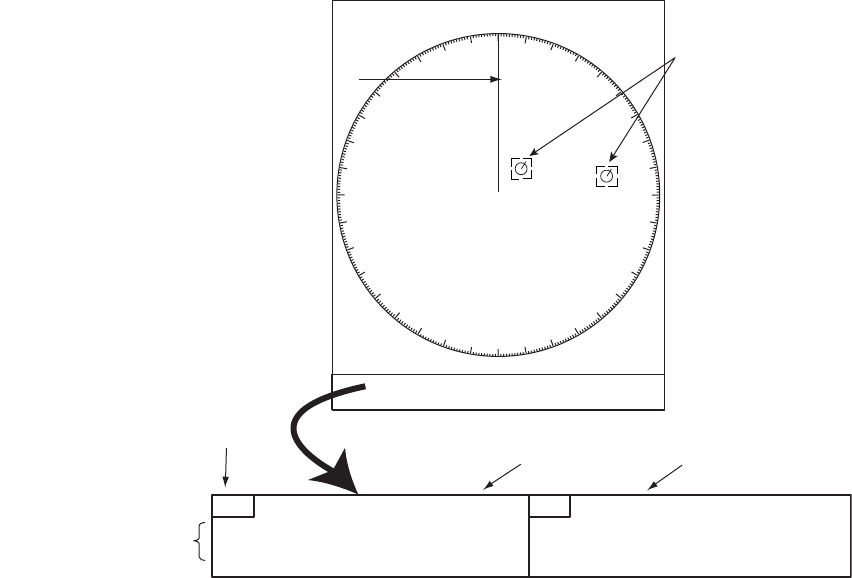
3. ARPA OPERATION
3-7
3.8 ARPA Target Data
You can show the data for a tracked ARPA target in the data box at the bottom of the
screen. To display ARPA target data, the menu item [Display] on the [ARPA] menu
must be set for [On] and the menu item [Data Box] on the [Display] menu must be set
for [Target] or [All].
1. Use the CursorPad to put the cursor on an ARPA target.
2. Press the ENTER key to show the data of the target.
ARPA target data
The symbol for the selected ARPA target is enlarged double to identify it from other
symbols.
To remove the data of a target from a data box, put the cursor on its target symbol and
press the CANCEL/HL OFF key.
Vector reference
Vector time
Target no.
Bearing, range, course,
speed,CPA, TCPA
+
ARPA target
selected for
data display
(B)01
Data box
Cursor
TRUE 06:00<ARPA> No. 02
A
BRG 78.4ºT RNG 2.032NM
SOG 0.49KNCRS 73.0º
TRUE 06:00<ARPA> No. 01
B
BRG 29.3ºT RNG 0.659NM
SOG 0.10KNCRS 12.3º
(A)02
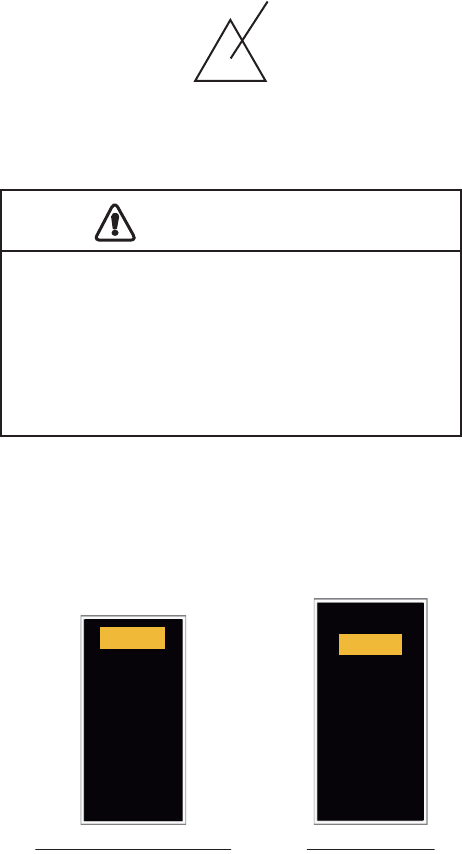
3. ARPA OPERATION
3-8
3.9 CPA/TCPA Alarm
Set [CPA] (Closest Point of Approach) alarm range and [TCPA] (predicted Time to
CPA) alarm time to alert you to the targets that can be on a collision course. When
[CPA] and [TCPA] of any ARPA target become less than the preset [CPA] and [TCPA]
alarm settings, the audio alarm sounds. The alarm message "COLLISION" appears.
The target symbol changes to a dangerous target symbol (triangle) and its vector
flashes. You can stop the audio alarm with any key. The flashing of the triangle stops
when the tracked CPA and TCPA of an ARPA target is not in the [CPA] and [TCPA]
alarm setting. The ARPA continuously monitors [CPA] and [TCPA] of all tracked ARPA
targets.
Dangerous target symbol
This feature helps identify the targets that can be on a collision course. Correctly ad-
just GAIN, A/C SEA, A/C RAIN and other radar controls.
1. Press the MENU key to open the menu.
2. Use S or T to select [Target] and press the ENTER key.
3. Use S or T to select [CPA] and press the ENTER key.
4. Use S or T to select [CPA] distance and press the ENTER key.
5. Use S or T to select [TCPA] and press the ENTER key.
6. Use S or T to select TCPA and press the ENTER key.
7. Press the MENU key to close the menu.
CAUTION
CAUTION
Do not depend on the CPA/TCPA alarm
as the only method to detect the risk of
collision. The navigator is not released
of the responsibility to keep visual caution
for collision situations, whether or not the
radar or other plotting aid is in use.
Off
0.5NM
1NM
2NM
3NM
5NM
6NM 6min
30s
2min
3min
4min
5min
1min
12min
CPA distance settings TCPA settings
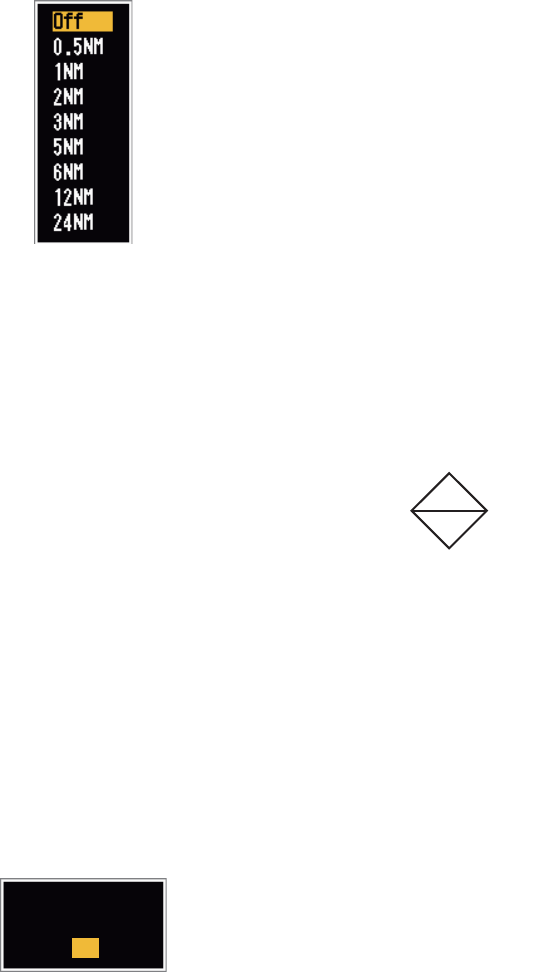
3. ARPA OPERATION
3-9
3.10 Proximity Alarm
The proximity alarm alerts you when an ARPA target is within the range you set. The
audio alarm sounds and the alarm message "PROXIMITY" appears. The target sym-
bol changes to a dangerous target symbol (triangle, see section 3.9) and flashes with
its vector. Press any key to stop the audio alarm. The flashing continues until the tar-
get is not within the range set, the alarm range is changed to exclude the target, or the
proximity alarm is deactivated.
1. Press the MENU key to open the menu.
2. Use S or T to select [Target] and press the ENTER key.
3. Use S or T to select [Proximity] and press the ENTER key.
Proximity settings
4. Use S or T to select the range and press the ENTER key.
5. Press the MENU key to close the menu.
3.11 Lost Target
When the system detects a lost target, the audio alarm sounds
and the alarm message "LOST" appears. The target symbol
becomes a flashing square like the illustration to the right.
When the system detects the target again, the target symbol
becomes a normal symbol.
To erase a lost target symbol, put the cursor on the symbol and press the CANCEL/
HL OFF key. If you leave a lost target symbol flashing, the symbol disappears after
one minute.
You can remove all lost ARPA targets from the screen as follows:
1. Press the MENU key to open the menu.
2. Use S or T to select [ARPA] and press the ENTER key.
3. Use S or T to select [ACK Lost Targets] and press the ENTER key.
ACK Lost Targets options
4. Use S to select [Yes] and press the ENTER key. All lost targets symbols are
erased from the screen and the long beep sounds.
5. Press the MENU key to close the menu.
Lost target symbol
Are you sure?
Yes
No

3. ARPA OPERATION
3-10
3.12 Symbol Color
You can select the ARPA symbol color from Green, Red, Blue, White or Black.
1. Press the MENU key to open the menu.
2. Use S or T to select [ARPA] and press the ENTER key.
3. Use S or T to select [Color] and press the ENTER key.
Color options
4. Use S or T to select the color and press the ENTER key.
5. Press the MENU key to close the menu.
Note: Symbols can not be shown in the same color as the background color.
Red
Blue
White
Black
Green

4-1
4. AIS OPERATION
Connected to the FURUNO AIS Transponders FA-150, FA-100, FA-50 or the AIS Re-
ceiver FA-30, the FR-8045/FR-8065/FR-8125/FR-8255 series can show the name,
position and other navigation data of the nearest 100 AIS transponder-equipped
ships.
This radar accepts heading and position data fixed by WGS-84 geodetic datum. Set
the datum to WGS-84 on the GPS navigator connected to this radar. If this radar is
connected with the FURUNO GPS Navigator GP-320B, see section 5.2 for the proce-
dure.
4.1 Controls for Use with AIS
ENTER: Activate the cursor-selected target. Display data for the selected active target
(in the data box at the bottom of the screen).
CANCEL/HL OFF: Remove data of cursor-selected AIS target from the data box.
Sleep the cursor-selected target (when its data is not displayed in the data box).
MENU: Access the [Target] and [AIS] menus for AIS operations.
CursorPad: Select a target to activate (or sleep). Select a target to show (or remove)
target data.
4.2 AIS Display On/Off
You can turn the AIS display on or off. The system continues processing AIS targets
regardless of on/off for AIS display when the AIS transponder is turned on.
1. Press the MENU key to open the menu.
2. Use S or T to select [AIS] and press the ENTER key.
AIS menu
Custom 1
Custom 2
Custom 3
Alarm
Target Trails
Tuning
Others
Target
ARPA
AIS
GPS
Color
Number of Targets
Sort By
Sector End
: Green
: 30
: Range
: 24.0NM
Sector Start : 340°
Range
Ignore Slow Targets
ACK Lost Targets
: 20°
: 5.0kn
Display : On
[ENTER]: Enter
[MENU]: Exit
[CANCEL/HL OFF]: Back
Turning on/off AIS display
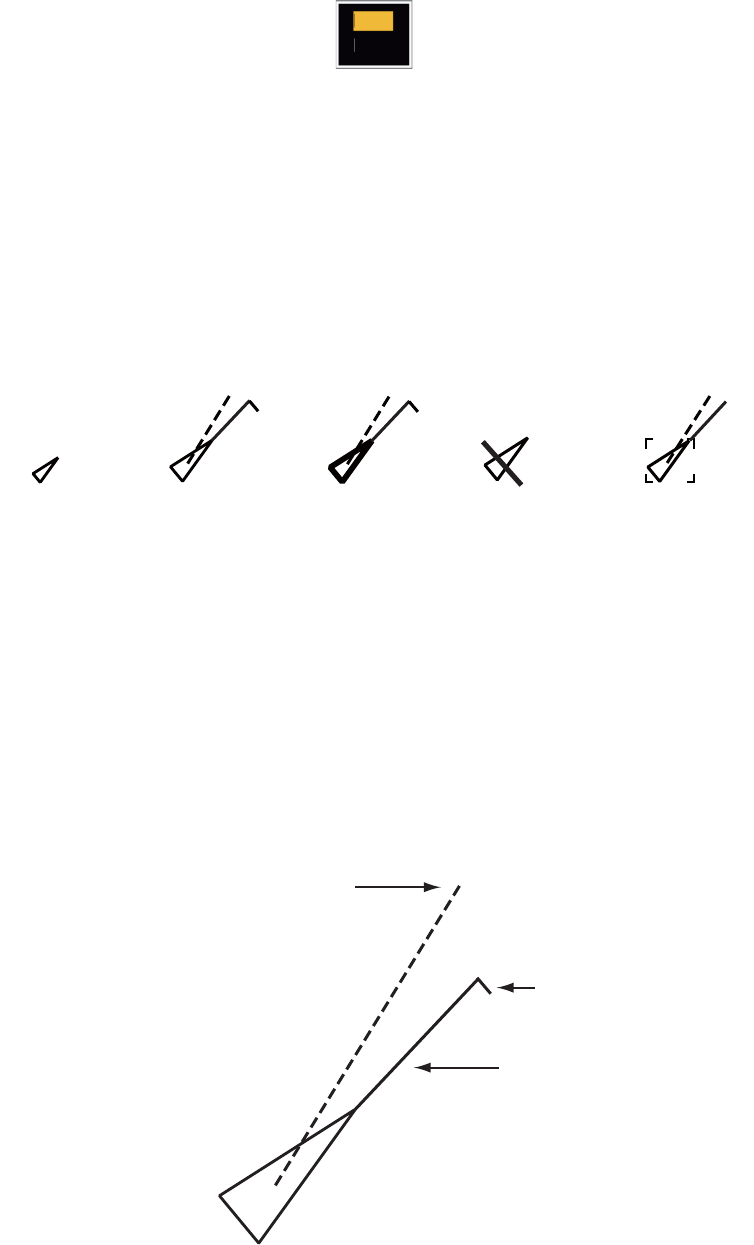
4. AIS OPERATION
4-2
3. Use S or T to select [Display] and press the ENTER key.
AIS-Display options
4. Use S or T to select [Off] or [On] then press the ENTER key.
5. Press the MENU key to close the menu.
4.3 AIS Symbols
When the AIS is turned on, AIS targets are displayed with AIS symbol as shown be-
low.
AIS symbols
Note: When the heading is changed on the head up mode, the AIS symbols are
erased, after the screen is changed, for a short time.
4.4 Activating, Sleeping Targets
When you change a sleeping target to an activated target, a vector shows the course
and speed of that target. You can easily judge the target movement by the vector.
Activated target
Off
On
Sleeping
target Activated
target
Dangerous
target
Lost target Target selected
for data display
Heading line
SOG (Speed Over Ground) and
COG (Course over Ground) vector
(If there is no heading data,
the line points in direction of COG.)
ROT
(Rate of Turn)
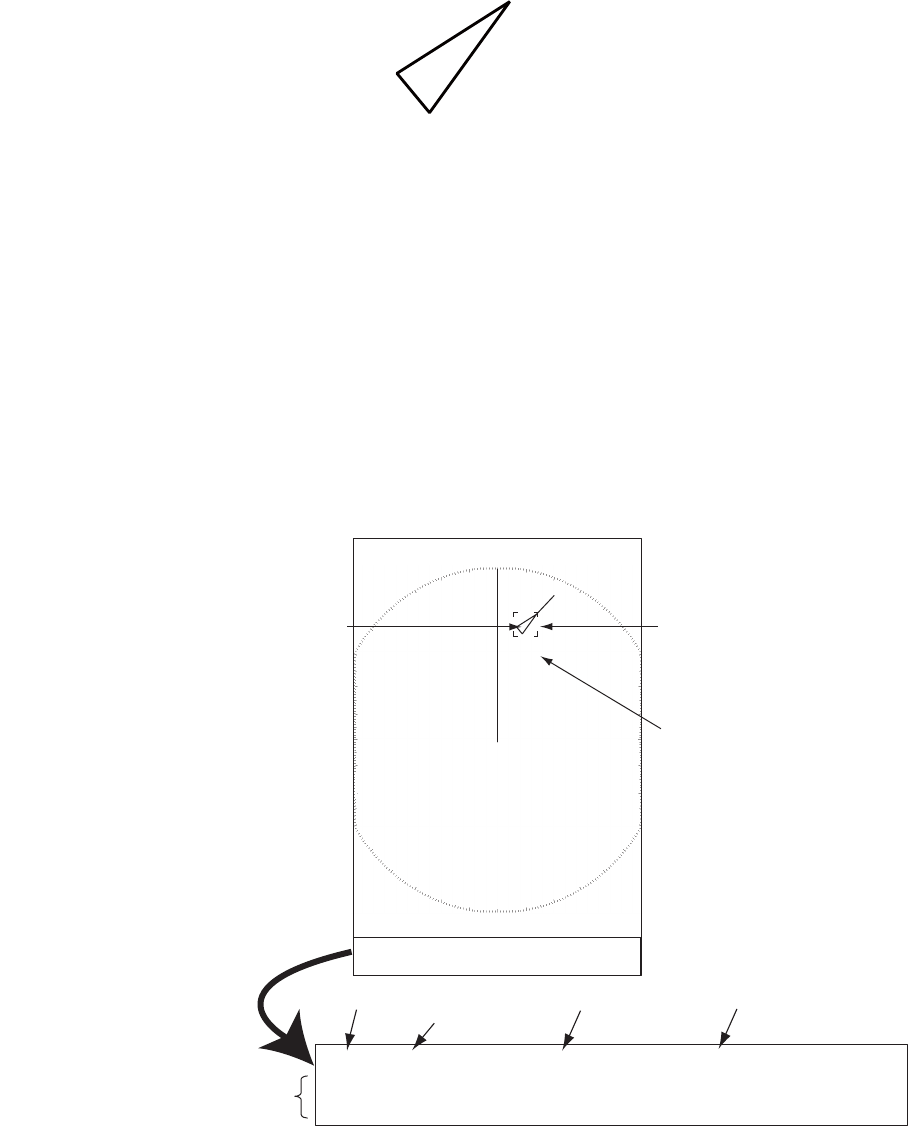
4. AIS OPERATION
4-3
When there are many activated targets on the screen, you can not easily identify the
activated targets from the radar images or ARPA targets. You can sleep an activated
target for easy view of radar images.
Sleeping target
To activate a target: Put the cursor on the target and press the ENTER key.
To sleep a target: Put the cursor on the target and press the CANCEL HL/OFF key.
4.5 AIS Target Data
You can show the AIS target data in the data box at the bottom of the screen. To dis-
play AIS target data, the menu item [Display] on the [AIS] menu must be set for [On]
and the menu item [Data Box] on the [Display] menu must be set for [Target] or [All].
1. Use the CursorPad to put the cursor on an activated target.
2. Press the ENTER key to show the data of the target.
To remove the target data from a data box, put the cursor on its target symbol and
press the CANCEL/HL OFF key.
AIS target
selected for
data display
MMSI of vessel Name of
vessel
PEGASUS
Cursor
Data box
TRUE 05:00 <AIS> MMSI: 123456789 NAME: PEGASUS
BRG
53.7°T
RNG 2.987NM COG
350.4°
SOG 23.45KN
CPA 1.65NM TCPA 06:14 LEN 100M BEAM 45M
Vector reference
Vector time
Bearing, range, course, speed
CPA, TCPA, length, beam of vessel
+
Name of vessel
(or MMSI)

4. AIS OPERATION
4-4
4.6 How to Sort Targets
You can sort the AIS targets received from the AIS transponder by range from your
ship, by sector, by CPA or TCPA.
1. Press the MENU key to open the menu.
2. Use S or T to select [AIS] and press the ENTER key.
3. Use S or T to select [Sort By] and press the ENTER key.
Sort By options
4. Use S or T to select sorting method and press the ENTER key.
[Range]: Sort targets within the display range set (see section 4.7), from nearest
to furthest.
[Sector]: Sort targets within the display sector set (see section 4.8) and within 24
nm, from nearest to furthest.
[CPA]: Sort targets within 24 nm by CPA, from closest to furthest.
[TCPA]: Sort targets within 24 nm by TCPA, from earliest time to latest time.
5. Press the MENU key to close the menu.
4.7 Display Range
You can set the AIS system to show only those AIS targets within the range you set.
The setting range is 0.1NM - 48.0NM for FR-8045, 0.1NM - 72.0NM for FR-8125/FR-
8065 and 0.1NM - 96.0NM for FR-8255. Actual range depends on the AIS Transpon-
der. If the target sorting method is selected to [Range], the target data within the range
set here are transmitted to this radar.
1. Press the MENU key to open the menu.
2. Use S or T to select [AIS] and press the ENTER key.
3. Use S or T to select [Range] and press the ENTER key.
AIS-Range setting window (for FR-8255)
4. Use S or T to set the display range and press the ENTER key.
5. Press the MENU key to close the menu.
Note: The unit of measurement for range is NM.
Range
Sector
CPA
TCPA

4. AIS OPERATION
4-5
4.8 How to Display the Targets within a Specific Sec-
tor
You can display AIS targets only within a specified sector. If the target sorting method
is selected to [Sector], the target data within the sector set here are transmitted to this
radar.
1. Press the MENU key to open the menu.
2. Use S or T to select [AIS] and press the ENTER key.
3. Use S or T to select [Sector Start] and press the ENTER key.
Sector Start setting window
4. Use S or T to set the start point for the sector and press the ENTER key.
5. Use S or T to select [Sector End] and press the ENTER key.
Sector End setting window
6. Use S or T to set the end point for the sector and press the ENTER key.
7. Press the MENU key to close the menu.
4.9 Number of Targets to Display
You can select the maximum number of AIS targets to display. The setting value is 10
to 100. When the screen becomes full of AIS targets, you can limit the number of AIS
targets to show. Targets are selected and displayed according to sort method. (See
section 4.6.)
1. Press the MENU key to open the menu.
2. Use S or T to select [AIS] and press the ENTER key.
3. Use S or T to select [Number of Targets] and press the ENTER key.
Number of Targets setting window
4. Use S or T to select the number of targets to display and press the ENTER key.
5. Press the MENU key to close the menu.

4. AIS OPERATION
4-6
4.10 Vector Attributes
4.10.1 What is a vector?
A vector is a line extending from a tracked target. A vector shows speed and course
of the target. The top of a vector shows estimated position of the target after the se-
lected vector time elapses. If you increase the vector length (time), you can evaluate
the risk of collision with any target.
4.10.2 Vector time and vector reference
1. Press the MENU key to open the menu.
2. Use S or T to select [Target] and press the ENTER key.
3. Use S or T to select [Vector Time] and press the ENTER key.
Vector Time setting window
4. Use S or T to select time and press the ENTER key.
5. Use S or T to select [Vector Reference] and press the ENTER key.
Vector Reference options
6. Use S or T to select [Relative] or [True] then press the ENTER key. This function
is not activate for [IEC] or [Russian-River] purpose. The mode is set to [True].
[Relative]: Other ships’ vectors are displayed relative to your ship. This mode
helps find targets on a collision course. If a ship is on a collision course with your
ship, the vector of a ship points toward your ship position.
[True]: Your ship’s and other ships’ vectors are displayed at their true motions.
This mode helps see the differences between moving and stationary targets.
7. Press the MENU key to close the menu.
6min
( 1min~30min)
True
Relative
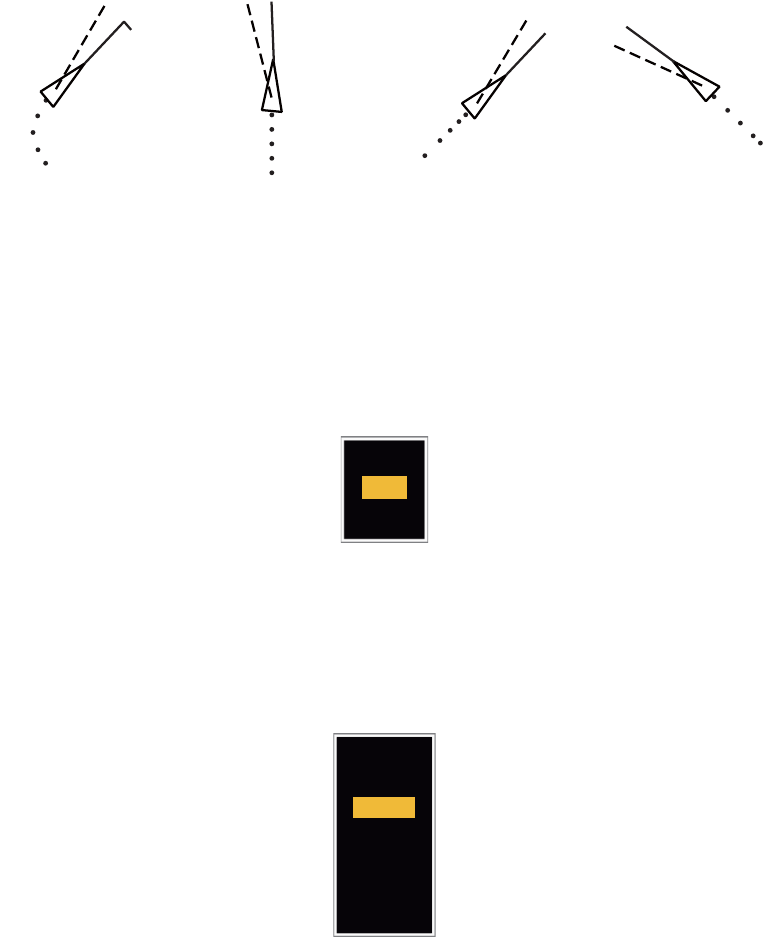
4. AIS OPERATION
4-7
4.11 History Display (target past position)
This radar can display time-spaced dots (maximum ten dots) that marks the past po-
sitions of any tracked AIS target. You can evaluate actions of a target by the spaces
between the dots. Below are examples of dot spacing and target movement.
You can select the number of history dots to display and the time interval to display
the history dots.
1. Press the MENU key to open the menu.
2. Use S or T to select [Target] and press the ENTER key.
3. Use S or T to select [History Dots] and press the ENTER key.
History Dots options
4. Use S or T to select number of history dots to display (5 or 10) or select [Off] to
turn off the history display.
5. Press the ENTER key.
6. Use S or T to select [History Interval] and press the ENTER key.
History Interval options
7. Use S or T to select time interval and press the ENTER key.
8. Press the MENU key to close the menu.
(a) Ship turning (b) Ship running
straight
(c) Ship reduced
speed
(d) Ship increased
speed
Off
10
5
15s
30s
2min
3min
6min
12min
1min

4. AIS OPERATION
4-8
4.12 CPA/TCPA Alarm
Set CPA (Closest Point of Approach) alarm range and TCPA (predicted Time to CPA)
alarm time to alert you to targets that can be on a collision course. When CPA and
TCPA of any AIS target (including a sleeping target) become less than the preset CPA
and TCPA alarm settings, the audio alarm sounds. The alarm message "COLLISION"
appears. The target symbol changes to a dangerous target symbol (red) and its vector
flashes. You can stop the audio alarm and flashing with any key. The dangerous target
symbol is displayed until the AIS target is not in the CPA and TCPA alarm setting. The
AIS continuously monitors CPA and TCPA of all AIS targets.
This feature helps identify the targets that can be on a collision course.
1. Press the MENU key to open the menu.
2. Use S or T to select [Target] and press the ENTER key.
3. Use S or T to select [CPA] and press the ENTER key.
CPA options
4. Use S or T to select [CPA] distance and press the ENTER key.
5. Use S or T to select [TCPA] and press the ENTER key.
TCPA options
6. Use S or T to select [TCPA] and press the ENTER key.
7. Press the MENU key to close the menu.
0.5NM
1NM
2NM
3NM
6NM
5NM
Off
12min
6min
5min
4min
3min
2min
1min
30s

4. AIS OPERATION
4-9
4.13 Proximity Alarm
The proximity alarm alerts you when an AIS target is within the range you set. The au-
dio alarm sounds and the alarm message "PROXIMITY" appears. The target symbol
changes to a dangerous target symbol (red) and its vector flashes. Press any key to
stop the audio alarm and flashing. The dangerous target symbol is displayed until the
target is not within the range set, or the alarm range is changed to exclude the target,
or the proximity alarm is deactivated.
1. Press the MENU key to open the menu.
2. Use S or T to select [Target] and press the ENTER key.
3. Use S or T to select [Proximity] and press the ENTER key.
Proximity options
4. Use S or T to select the range and press the ENTER key.
5. Press the MENU key to close the menu.
4.14 Lost Target
When AIS data is not received from a target at fixed interval (3-5* report intervals), the
target symbol changes to the lost target symbol (flashing). No audio or visual alarm is
given for a lost target.
Lost target symbol
* The interval at which AIS data is sent depends on speed of the AIS transponder. For
detailed information, refer to the Operator's Manual for the AIS transponder.
You can remove all lost AIS targets from the display as follows:
1. Press the MENU key to open the menu.
2. Use S or T to select [AIS] and press the ENTER key.
3. Use S or T to select [ACK Lost Targets] and press the ENTER key.
ACK Lost Targets options
24NM
12NM
6NM
5NM
3NM
2NM
1NM
0.5NM
Off
Are you sure ?
Yes
No

4. AIS OPERATION
4-10
4. Use S to select [Yes] and press the ENTER key. All lost targets symbols are
erased from the screen and the long beep sounds.
5. Press the MENU key to close the menu.
4.15 Symbol Color
You can select the AIS symbol color from Green, Red (not available in the [IEC] or
[Russian-River] purpose), Blue, White or Black.
1. Press the MENU key to open the menu.
2. Use S or T to select [AIS] and press the ENTER key.
3. Use S or T to select [Color] and press the ENTER key.
Color options
4. Use S or T to select the color and press the ENTER key.
5. Press the MENU key to close the menu.
Note: Symbols can not be shown in the same color as the background color.
4.16 How to Ignore Slow Targets
You can prevent activation of the CPA/TCPA alarm against AIS targets that move at
a speed lower than set here. The AIS symbols are not affected by this setting.
1. Press the MENU key to open the menu.
2. Use S or T to select [AIS] and press the ENTER key.
3. Use S or T to select [Ignore Slow Targets] and press the ENTER key.
Ignore Slow Targets settings window
4. Use S or T to select speed (0.0 - 9.9 kn) and press the ENTER key.
5. Press the MENU key to close the menu.
Green
Red
Blue
White
Black

5-1
5. GPS OPERATION
If the FURUNO GPS Navigator GP-320B is connected to this radar, you can set GP-
320B from this radar.
5.1 Navigator Mode
1. Press the MENU key to open the menu.
2. Use S or T to select [GPS] and press the ENTER key.
3. Use S or T to select [Mode] and press the ENTER key.
Mode options
4. Use S or T to select [GPS] or [WAAS] then press the ENTER key.
5. Press the MENU key to close the menu.
5.2 Datum
Select the type of datum which matches the paper charts you use for navigation. Se-
lect [WGS-84] if the radar is connected to an AIS Transponder.
1. Press the MENU key to open the menu.
2. Use S or T to select [GPS] and press the ENTER key.
3. Use S or T to select [Datum] and press the ENTER key.
Datum options
4. Use S or T to select the type of datum and press the ENTER key. If you select
[WGS-84] or [Tokyo], go to step 7. If you select [Other], go to the next step.
5. Use S or T to select [Datum No] and press the ENTER key.
Datum No setting window
6. Use S or T to select the datum number and press the ENTER key. (The setting
range is 001 - 192 and 201 - 254. Refer to the page AP-5 “GEODETIC CHART
LIST”).
7. Press the MENU key to close the menu.
WAAS
GPS
WGS-84
Tokyo
Other

5. GPS OPERATION
5-2
5.3 WAAS Setup
Geostationary satellites, the type used with WAAS, provide more accurate position
data when compared to GPS. These satellites can be tracked automatically or manu-
ally. Auto tracking automatically searches for the best geostationary satellite from your
current position.
1. Press the MENU key to open the menu.
2. Use S or T to select [GPS] and press the ENTER key.
3. Use S or T to select [WAAS] and press the ENTER key.
WAAS options
4. Use S or T to select [AUTO] or [MANUAL] and press the ENTER key. If you se-
lect [Auto], go to step 7. If you select [Manual], go to the next step.
5. Use S or T to select [WAAS No] and press the ENTER key.
WAAS No setting window
6. Use S or T to select WAAS number and press the ENTER key.
(The setting range is 120 - 158. Refer to the following table.)
7. Press the MENU key to close the menu.
Provider Satellite type Longitude Satellite No
WAAS
Inmarsat-3-F4 (AOR-W) 142°W 122
Inmarsat-3-F3 (POR) 178°E 134
Intelsat Galaxy XV 133°W 135
TeleSat Anik F1R 107.3°W 138
EGNOS
Inmarsat-3-F2 (AOR-E) 15.5°W 120
Artemis 21.5°E 124
Inmarsat-3-F5 (IOR-W) 25°E 126
MSAS
MTSAT-1R 140°E 129
MTSAT-2 145°E 137
Manual
Auto
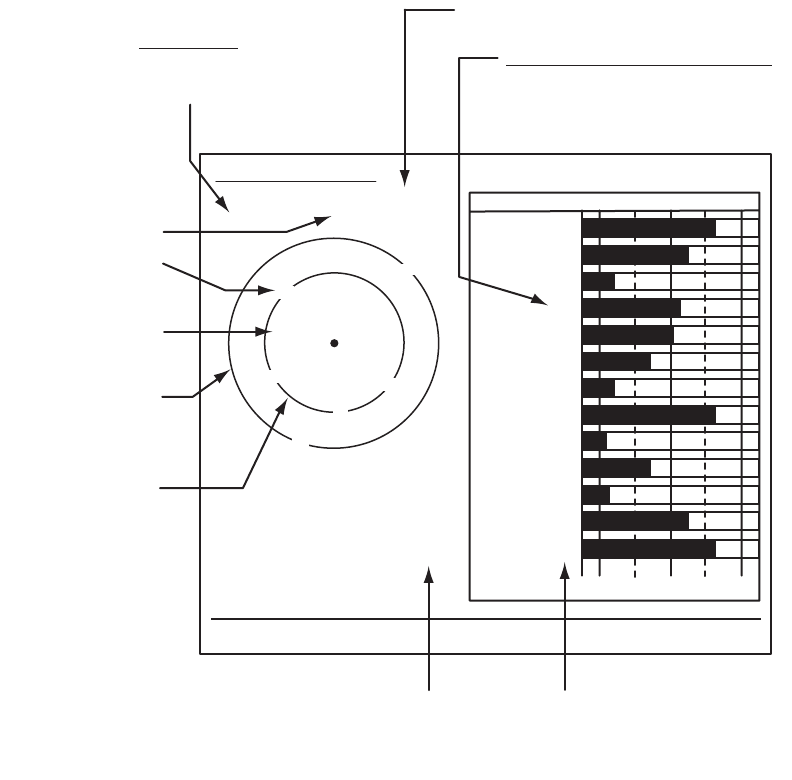
5. GPS OPERATION
5-3
5.4 Satellite Monitor
The Satellite Monitor provides the information about GPS and WAAS satellites. See
your GPS navigator's owner's manual for detailed information.
1. Press the MENU key to open the menu.
2. Use S or T to select [GPS] and press the ENTER key.
3. Use S or T to select [Satellite Monitor] and press the ENTER key.
Satellite monitor
4. Press the ENTER key to close only the satellite monitor display.
06
W3D DOP
1.5
15m
13
Altitude
01GPS
WAAS
12
24
16
SNRSatellite No.
30 40 50
122
01
31
18
19
06
07
09
08
13
North marker
DOP (Dilution of Precision, 0.0 - 99.0)
SNR of tracked GPS satellites
Satellites whose SNR is above
40 are used to fix position.
GPS mode
2D, 3D,
W2D, W3D
GPS satellite no.*
WAAS satellite
Satellites in ring
have elevation
angle of 5°
Satellites in ring
have elevation
angle of 45°
Altitude of
GPS antenna
from sea
surface
SNR of tracked
WAAS satellite
W
N
[MENU]: Close MENU [ENTER]: Close this window
* Satellites used to fix
position are shown in red.
Satellite Monitor
01
09
24
12
19
18
07
13
16
08
31

5. GPS OPERATION
5-4
5.5 Cold Start
Cold start, which clears the Almanac from the GPS receiver, can be necessary in the
following conditions:
• If you have turned off the power of the GPS receiver for a long time.
• The ship has moved far away from the previous fixing position (e.g., more than 500
km).
• Other reason that prevents the receiver from finding its position within five minutes
after you turn on the power.
To cold start, do the following:
1. Press the MENU key to open the menu.
2. Use S or T to select [GPS] and press the ENTER key.
3. Use S or T to select [Cold Start] and press the ENTER key.
Cold Start options
4. Use S or T to select [Yes] and press the ENTER key. After processing cold start,
the long beep sounds. (To stop cold start, press the CANCEL/HL OFF key instead
of the ENTER key.)
5. Press the MENU key to close the menu.
Are your sure ?
Yes
No
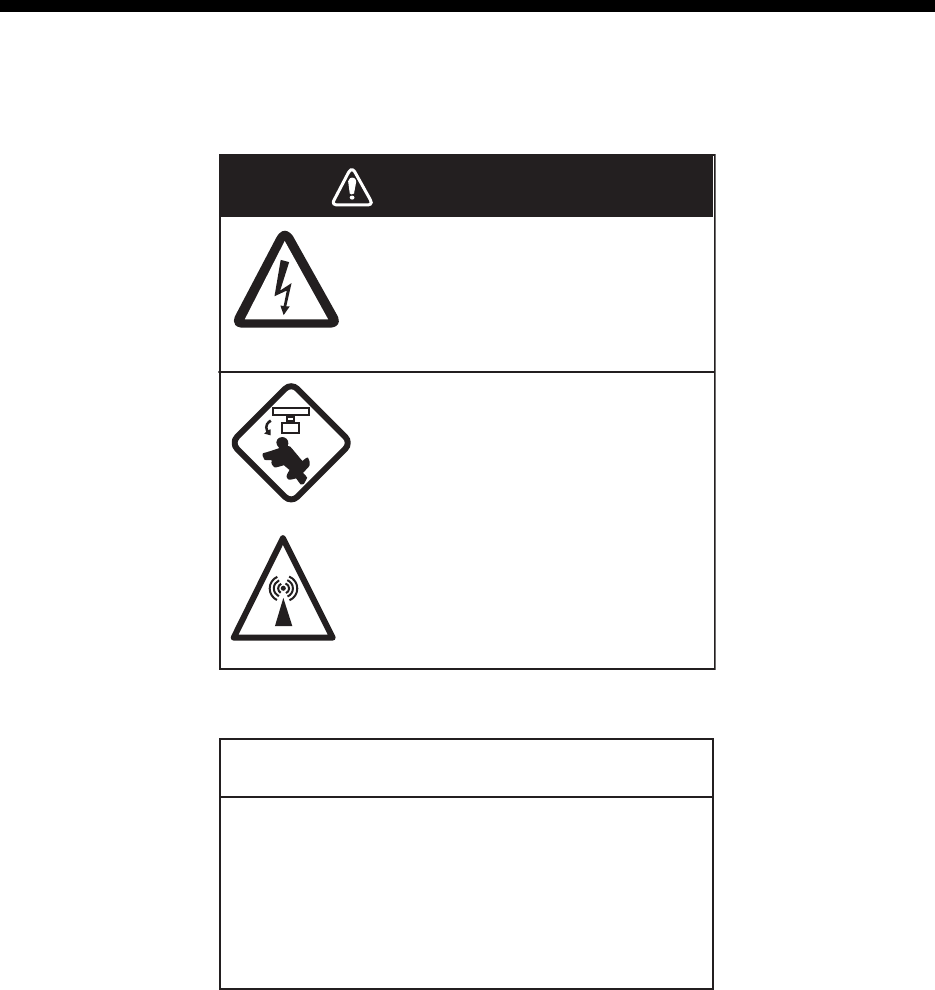
6-1
6. MAINTENANCE, TROUBLE-
SHOOTING
This chapter has information about maintenance and troubleshooting that the user
can follow to care for the equipment.
WARNING
ELECTRICAL SHOCK HAZARD
Do not open the equipment.
Only qualified personnel can work
inside the equipment.
Turn off the power before you
service the antenna unit. Post
a warning sign near the power
switch not to turn on the power
while you service the antenna
unit.
Prevent the potential risk of being
struck by the rotating antenna and
exposure to RF radiation hazard.
NOTICE
Do not apply paint, anti-corrosive sealant
or contact spray to plastic parts or
equipment coating.
These items contain products that can
damage plastic parts and equipment coating.
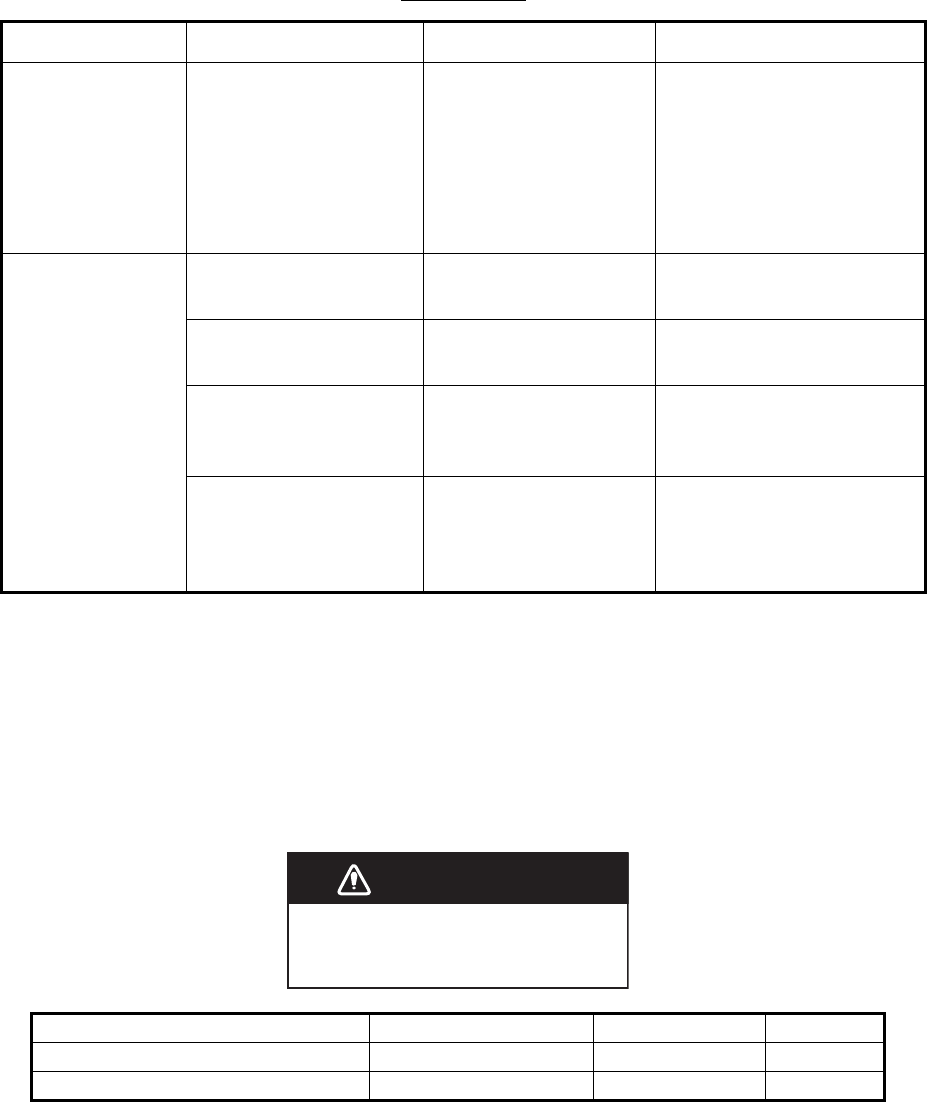
6. MAINTENANCE, TROUBLESHOOTING
6-2
6.1 Preventative Maintenance
Regular maintenance helps keep your equipment in good condition and prevents fu-
ture problems. Check the items shown in the table below to help keep your equipment
in good condition for years to come.
Maintenance
6.2 Fuse Replacement
A fuse is in the fuse holder on the power cable and inside the power supply unit, and
they protect the equipment from reverse polarity of the ship's mains and equipment
fault. If a fuse blows, find out the cause before replacing it. Use the correct fuse. Using
the wrong fuse will damage the equipment and void the warranty.
Interval Item Check Point Remedy
When necessary LCD Dust on the LCD Remove the dust from the
LCD with the tissue paper
and an LCD cleaner. To re-
move dirt or salt, use the
LCD cleaner. Change the
tissue paper often so as
not to damage the LCD.
3 to 6 months Ground terminal on dis-
play unit
Check for tight connec-
tions and corrosion
Tighten or replace as nec-
essary.
Display unit connectors Check for tight connec-
tion.
Tighten if the connectors
are loosened.
Exposed nuts and bolts
on the antenna unit.
Check for corroded or
loosened bolts.
Clean and repaint as nec-
essary. Use sealing com-
pound instead of paint.
Antenna radiator Check for dirt and
cracks on the radiator
surface.
Clean radiator surface with
a fresh-water-moistened
cloth. Do not use plastic
solvents to clean.
Unit Type Code No. Remarks
Display unit (fitted on power cable) FGBO 125V 10A PBF 000-155-826-10 24VDC
Power supply unit (for FR-8255) FGBO 125V 7A PBF 000-155-831-10 24VDC
WARNING
Use the proper fuse.
Use of a wrong fuse can result in damage
to the equipment and cause fire.

6. MAINTENANCE, TROUBLESHOOTING
6-3
6.3 Magnetron Life
When the life of the magnetron is reached, the targets do not appear on the display.
If long-range performance appears to have decreased, contact a FURUNO agent or
dealer about replacement of the magnetron. The magnetron changes with the type of
antenna unit.
6.4 LCD Backlight Life
The life of the LCD backlight, which provides the illumination for the LCD, is approxi-
mately 70,000 hours at 25°C (ambient temperature).
Model Magnetron Type Code No. Estimated life expectancy
FR-8045 E3571 000-146-867-12 App. 2,000 hours
FR-8065 MAF1422B 000-158-788-12 App. 3,000 hours
FR-8125 MAF1565N 000-174-559-11 App. 3,000 hours
FR-8255 M1458F 000-159-904-12 App. 2,000 hours

6. MAINTENANCE, TROUBLESHOOTING
6-4
6.5 Simple Troubleshooting
This section provides simple troubleshooting procedures which the user can follow to
restore normal operation. If you cannot restore normal operation, do not check inside
the unit. Have a qualified technician check the equipment.
Problem Remedy
You cannot turn on the power. • Check for blown fuse.
• Make sure that the power connector is
fastened.
• Check for corrosion on the power cable
connector.
• Check for damaged power cable.
• Check the battery for correct voltage
output.
There is no response when a key is
pressed.
Turn the power off, then on. If you do not
get a response, the key is damaged. Con-
tact your dealer for instructions.
The power is on and you operated the
STBY/TX key to transmit. The marks and
letters appear, but no echo appears.
Make sure that the antenna cable is fas-
tened.
Tuning is correctly adjusted, but sensitivity
is poor.
Replace the magnetron. Contact your
dealer.
The range is changed, but radar picture
does not change.
• Try to press the RANGE key again.
• Turn the display unit off then on.
Poor discrimination in range because of
too many echoes from the waves.
Adjust the A/C SEA control.
The true motion presentation is not work-
ing correctly.
• Make sure that the setting of [Display
Mode] in the [Display] menu is set to
[True Motion].
• Make sure that the heading and position
data are inputted and correct.
The range rings are not displayed. Make sure that the setting of [Rings Brill] in
the [Brill/Color] menu is not set to [Off].
Target is not tracked correctly because of
sea clutter.
Adjust A/C SEA and A/C RAIN controls.

6. MAINTENANCE, TROUBLESHOOTING
6-5
6.6 Advanced-level Troubleshooting
This section describes how to cure hardware and software troubles which only quali-
fied service persons must do.
Problem Possible cause or check
points Remedy
Power cannot be turned on. 1) Mains voltage/polarity
2) Power supply board
1) Correct the wiring and input
voltage.
2) Replace the power board.
Brilliance adjusted but no
picture.
1) SPU Board 1) Replace SPU Board.
Antenna not rotating. 1) Antenna drive mechanism 1) Replace the antenna drive
mechanism.
Data and marks not dis-
played in transmit.
1) SPU board 1) Replace SPU board.
Set GAIN to the maximum
with A/C SEA set at mini-
mum. Marks and indications
appear but no noise or echo.
1) Signal between antenna and
display unit
2) IF amplifier
3) Video amplifier board
1) Check continuity and isola-
tion of coaxial cable.
2) Replace IF amplifier.
3) Check coax line for fasten
connection. If the connection
is good, replace SPU board.
Marks, indications and noise
appear but no echo. (Trans-
mission leak show your ship
position is not present.)
1) Magnetron
2) Modulator board
3) SPU board
1) Check magnetron current.
2) Replace modulator board.
3) Replace the SPU board.
Picture not updated or pic-
ture freeze-up.
1) Bearing signal generator
2) SPU board
3) Video freeze-up
1) Make sure that the signal ca-
bles are fastened.
2) Replace the SPU board.
3) Turn the radar off, then on.
Radar is correctly tuned but
sensitivity is weak.
1) [2nd Echo Rejector] is [ON]
2) Dirt on radiator face
3) Deteriorated magnetron
4) Detuned MIC
1) Turn off the [2nd Echo Rejec-
tor] from the [Echo] menu.
2) Clean the radiator.
3) Check the magnetron current
with the radar transmitting on
48 nm range. If the current is
below normal, magnetron
may be defective. Replace
the magnetron.
4) Check the MIC detecting cur-
rent. If MIC detecting current
is below normal value, the
MIC may be detuned.
Range changed but picture
does not change.
1) RANGE key has defaults
2) SPU board
3) Video freeze-up
1) Try to operate the RANGE
key. If you can not operate
the RANGE key, replace the
keypad.
2) Replace the SPU board.
3) Turn the radar off, then on.
Range rings are not dis-
played.
1) Adjust their brilliance on the
[Brill/Color] menu.
2) SPU board
1) Replace the associated cir-
cuit board if unsuccessful.
2) Replace the SPU board.
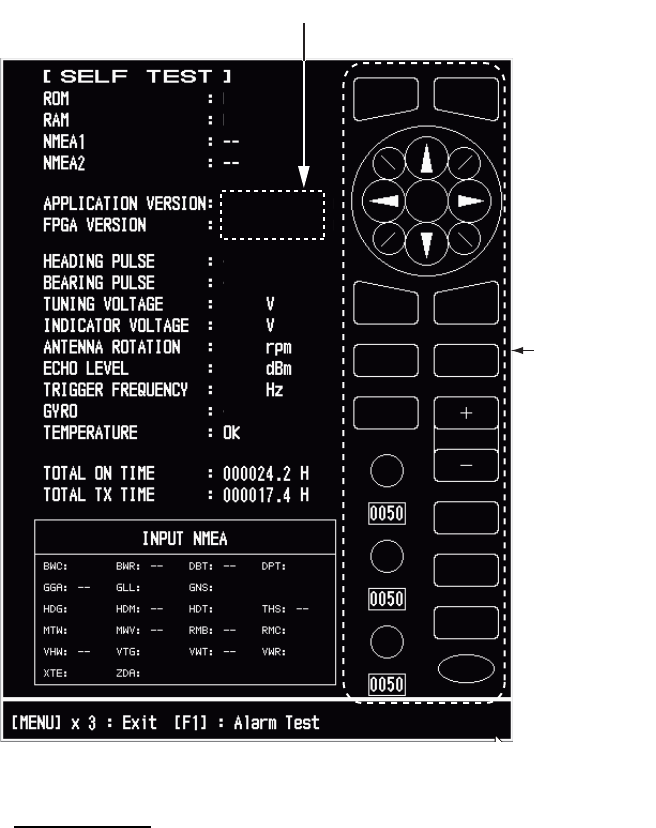
6. MAINTENANCE, TROUBLESHOOTING
6-6
6.7 Diagnostic Test
The diagnostic test checks the system for correct operation. This test is for use by ser-
vice technicians, but the user can do this test to provide the service technician with
information.
1. Press the MENU key to open the menu.
2. Use S or T to select [Tests] and press the ENTER key.
3. Use S or T to select [Self Test] and press the ENTER key.
Self Test screen
Test Results
• ROM, RAM: The results of the ROM and RAM test are displayed as "OK" or
"NG" (No Good).
• NMEA1, NMEA2: The results of the ports NMEA1 and NMEA2 are displayed as
"OK" or "- -". Ports NMEA1 and NMEA2 require a special connector to test
them. When a special connector is not connected, "- -" is shown. If "- -" is dis-
played with a special connector, contact your dealer for instruction.
• APPLICATION VERSION, FPGA VERSION: The program numbers and pro-
gram version numbers are displayed.
XX: Program version no.
OK
OK
OK
OK
10.1
4.2
48.1
-40
3112
123.4º
567
OK
OK
OK
OK
OK
OK
OK
OK
OK
OK
OK
OK
Key, buzzer,
knob control
and cursorpad
check
0359308-XX.XX
0359307-XX.XX

6. MAINTENANCE, TROUBLESHOOTING
6-7
• HEADING PULSE, BEARING PULSE: The results of the pulse input are dis-
played as "OK" or "NG". When [Antenna Rotation] is set to [Stop], or [Watch-
man] is set to [Off] in the STBY mode, this test is skipped and [- -] is shown for
both heading and bearing.
• TUNING VOLTAGE, INDICATOR VOLTAGE, ANTENNA ROTATION, ECHO
LEVEL, TRIGGER FREQUENCY: The results of measurement are displayed.
• GYRO: The current gyrocompass reading is displayed.
• TEMPERATURE: The result of the temperature test is displayed as "OK" or
"NG" and the temperature is measured and shown.
• TOTAL ON TIME, TOTAL TX TIME: The total number of hours, for which the
radar has been powered and has transmitted, are displayed.
• INPUT NMEA window: The condition of all the NMEA sentences being input to
this radar are displayed as "OK", or "- -". "- -" indicates no data input. Sentences
are updated every second.
Key check
Press each key one by one. A key’s on-screen location becomes green if the key
is normal.
Buzzer check
The F1 key tests on/off for the panel buzzer or external buzzer. To stop the buzz-
er, press the F1 key again.
Knob control check
Rotate each control knob. The four digits below the on-screen location for the
GAIN, A/C SEA and A/C RAIN knob controls show the control position. Press
each knob. The knob related on-screen circle changes in green if the knob is nor-
mal.
CursorPad check
Press each arrow and diagonal dot one by one. The on-screen location changes
in green if the key is normal.
4. Press the MENU key three times to leave the test.
5. Press the MENU key to close the menu.
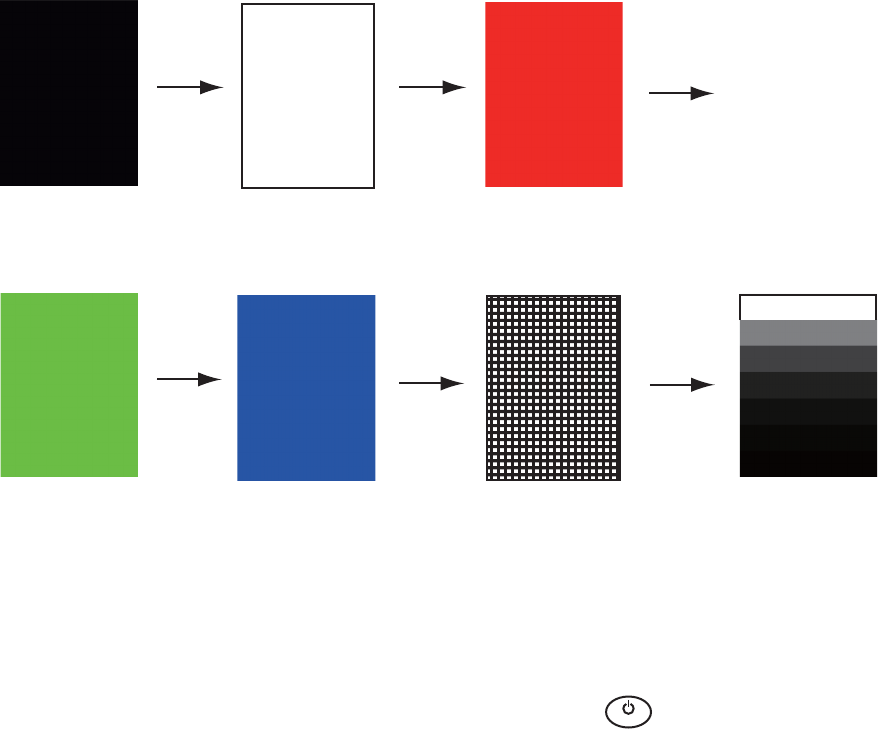
6. MAINTENANCE, TROUBLESHOOTING
6-8
6.8 LCD Test
1. Press the MENU key to open the menu.
2. Use S or T to select [Tests] and press the ENTER key.
3. Use S or T to select [LCD Pattern] and press the ENTER key.
4. Press the MENU key several times to close the menu.
Note 1: You can cancel the test at any time when you press the CANCEL/HL OFF
key.
Note 2: You can adjust the screen brilliance with the key during the test.
Black
MENU
key
MENU
key MENU
key
MENU
key MENU
key
MENU
key
White Red
Green Blue Checker board design 7 tones of gray
B
R
I
L
L

6. MAINTENANCE, TROUBLESHOOTING
6-9
6.9 ARPA Test
If the optional ARPA board is installed, its program number and test results ("OK" or
"NG") are shown on the screen. [ARPA Test] menu item does not operate when there
is no ARPA board. The radar must be transmitting to test the ARPA function.
1. Press the MENU key to open the menu.
2. Use S or T to select [Tests] and press the ENTER key.
3. Use S or T to select [ARPA Test] and press the ENTER key.
4. Press the MENU key three times to close the menu.
XXX: Program version no.
[ ARPA TEST ]
ROM : OK
RAM
: OK
ARPA VERSION
: 1859127XXX
SPEED : OK 12.3KN
COURSE
: OK 287.6
°
TRIGGER
: OK
VIDEO : OK
BEARING PULSE
: OK
HEADING PULSE : OK
MIN-HIT
: 0012
SCAN-TIME
: 0250
MANUAL-ACQ
: 03
AUTO-ACQ
: 05
FE-DATA1 : 0217
FE-DATA2 : 0023
ECHO NUMBER
[No. 1] 0123 [No. 2] 0321 [No. 3] 0084 [No. 4] 0234
[No. 5] 0110 [No. 6] 0219 [No. 7] 0073 [No. 8] 0145
[MENU] x 3 : Exit

6. MAINTENANCE, TROUBLESHOOTING
6-10
6.10 GPS Test
You can check the FURUNO GPS receiver GP-320B interfaced with this radar for cor-
rect operation as follows:
1. Press the MENU key to open the menu.
2. Use S or T to select [GPS] and press the ENTER key.
3. Use S or T to select [Self Test] and press the ENTER key. The program no. and
result of the test are shown, as "OK" or "NG" (No Good). When "NG" appears,
check the GPS receiver.
GPS Self Test screen
4. Press any key to close the test screen.
5. Press the MENU key to close the menu.
XX: Program version no. varies
according to equipment connected.
48502380XX
Self Test
Program No.
Result OK
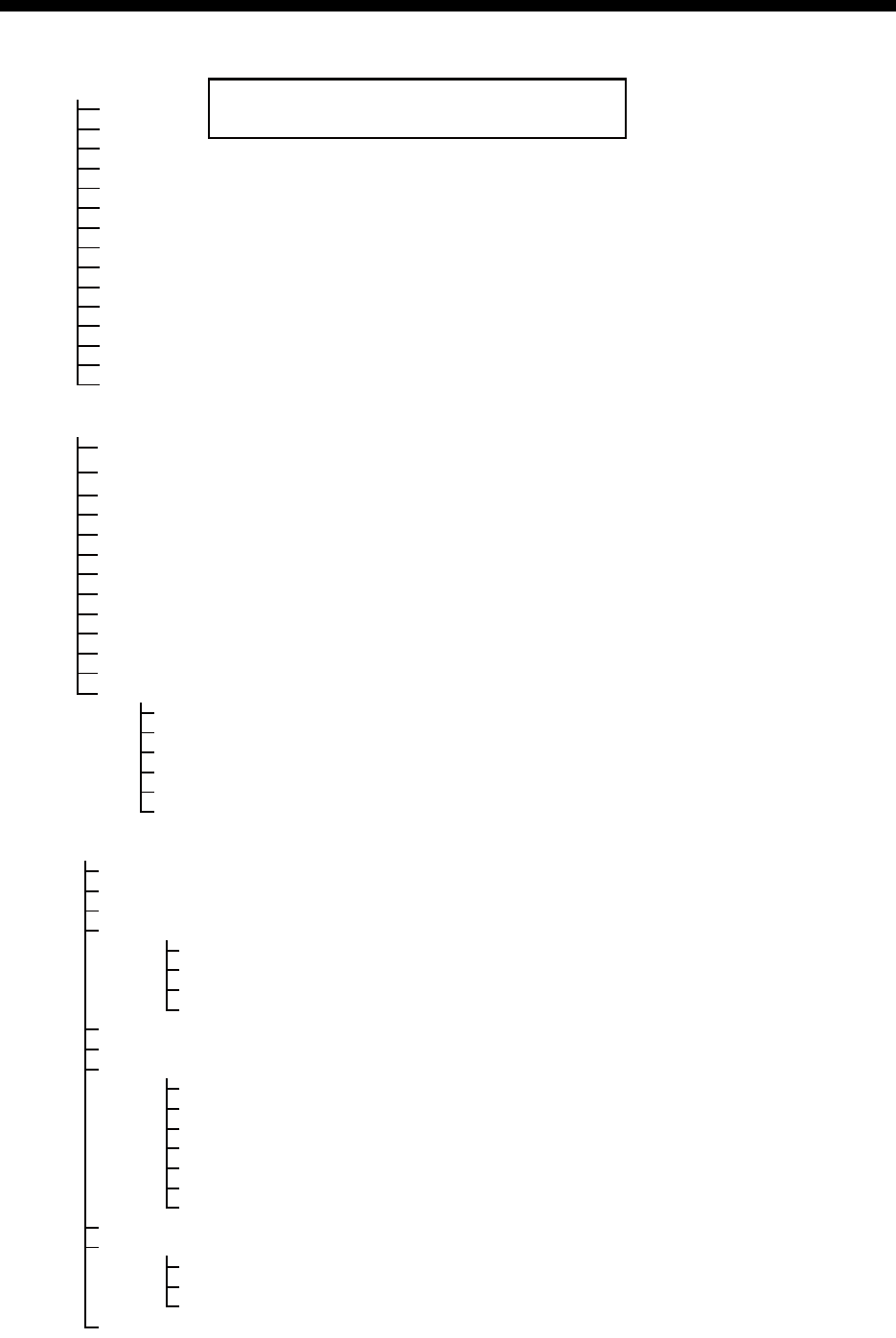
AP-1
APPENDIX 1 MENU TREE
Main Menu
1
Brill/Color Default settings and values shown in bold italics
2
Display
3
Echo
4
Custom 1
5
Custom 2
6
Custom 3
7
Alarm
8
Target Trails
9
Tuning
10
Others
11
Target
12
ARPA
13
AIS
14
GPS
15 System
1 Brill\Color
Echo Brill (1 - 8)
Rings Brill (1 - 4)
Mark Brill (1 - 4)
HL Brill (1 - 4)
Character Brill (1 - 4)
Echo Shading (1 - 5) Default: 3
Display Color (Day, Night, Twilight, Custom )
Echo Color (Yellow , Green, Orange, Multi)
Background Color (Black , DK Blue, Blue, White)
Character Color (Green, Red, White) Default: Green
Menu Transparency(OFF, 1, 2, 3, 4)
Echo Color Mode (System , Custom)
Custom Echo Color
Rank (1 - 31)
Red (0 - 63)
Green (0 - 63)
Blue (0 - 63) Default = 35
Fitting to Curve (-20 - 20) Default=0
Copy to Custom (Yes, No )
2 Display
Display Mode (Head Up , Course Up, North Up, True Motion, True View)
Zoom (Off , On)
Zoom Mode (Relative , True, Target)
Offcenter Mode
Manual (Off , On)
Custom (Off , On)
Auto (Off , On)
EXIT (YES , NO)
Save Offcenter (Yes, No)
Echo Area (Normal , Full Screen)
Base Text Display
Range (Off , On)
Mode (Off , On)
Alarm (Off , On)
Echo (Off , On)
EBL/VRM (Off , On)
+Cursor (Off , On)
EXIT (YES , NO)
Data Box (Off , Nav, Target, All)
Gain/Sea/Rain Bar
GAIN (0 - 100)
SEA (0 - 100)
RAIN (0 - 100)
STBY Display (Normal , Nav, Economy)

APPENDIX 1 MENU TREE
AP-2
3Echo
Gain Mode (Auto , Manual)
Sea Mode (Auto , Manual)
Auto Sea (Coastal, Advanced)
Rain Mode (Auto , Manual)
Auto Rain (Calm, Moderate , Rough)
A/C Auto (Off , On)
Pulse Length (Short , Medium, Long)
Echo Stretch (Off, 1, 2, 3)
Echo Average (Off, 1, 2, Auto)
Noise Rejector (Off , On)
Wiper (Off , 1, 2)
Int Rejector (Off , 1, 2, 3)
Display-Dynamic (Narrow, Normal , Wide)
Display-Curve (1, 2, 3)
Color Erase (0 - 11)
2nd Echo Rejector (Off , On)
4Custom 1
Custom1 (Off, On )
Copy
Gain Mode (Auto , Manual)
Manual Gain (0 - 100) Default: 80
Sea Mode (Auto , Manual)
Auto Sea (Coastal, Advanced)
Manual Sea (0 - 100)
Rain Mode (Auto , Manual)
Auto Rain (Calm, Moderate , Rough)
Manual Rain (0 - 100)
A/C Auto (Off , On)
Pulse Length (Short , Medium, Long)
Echo Stretch (Off , On)
Echo Average (Off , On)
Noise Rejector (Off , On)
Wiper (Off , 1, 2)
Int Rejector (Off , 1, 2, 3)
Display-Dynamic (Narrow, Normal , Wide)
Display-Curve (1, 2, 3)
Color Erase (0 - 11)
5
Custom 2 (Same as Custom1)
6
Custom 3 (Same as Custom1)
7Alarm
Target Alarm 1 (In, Out)
Target Alarm 2 (In, Out)
Alarm Level (Low, Med, High)
Watchman (Off , 5min, 10min, 20min)
Panel Buzzer (Off, On )
External Buzzer (Off, On )
Alarm Status
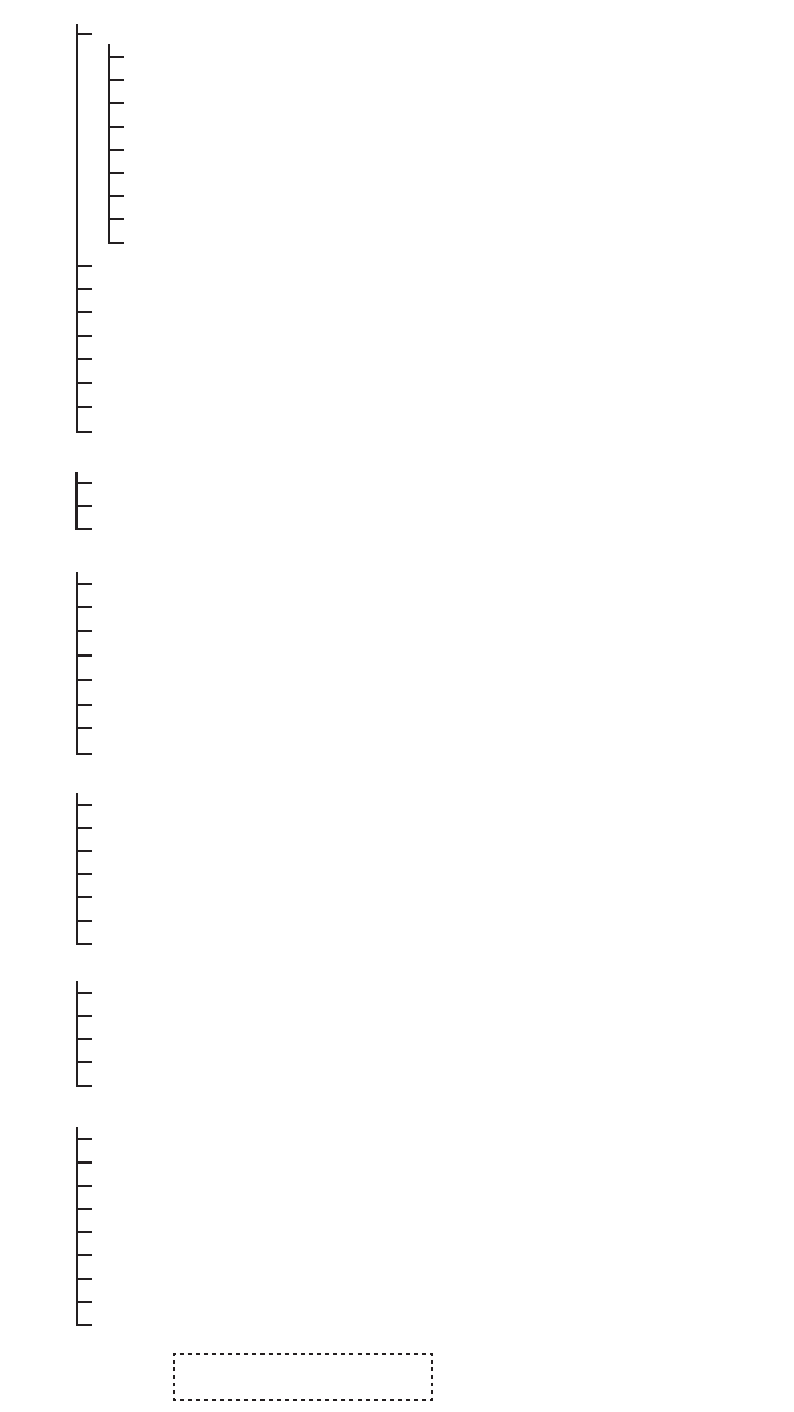
APPENDIX 1 MENU TREE
AP-3
Time
15s (Off, On )
30s (Off, On )
1min (Off, On )
3min (Off, On )
6min (Off, On )
15min (Off, On )
30min (Off, On )
Continuous (Off , On)
EXIT (YES ,NO)
Gradation (Single, Multi)
Color (Green, Red, Blue , White, Black)
Mode (Relative, True )
Level (1, 2, 3)
Restart (Off, On )
Narrow (Off , On)
Own Ship (Off , 1, 2)
All Cancel (Yes, No )
9 Tuning
10 Others
11 Target
12 ARPA
13 AIS
8 Target Trails
Tuning Mode (Auto, Manual)
Manual Tuning (0.00V - 12.00V) Default 6.00V
Tuning Init Adjust (Yes, No )
F1 Setup
F2 Setup
F3 Setup
WPT Mark (On, Off )
EBL Reference (Relative , True)
VRM Unit (NM , KM, SM, KYD, NM&YD)
Cursor Position (Rng/Brg , Lat,Lon)
TLL Key Mode (TLL Output , Origin Mark, Both)
Vector Time (1min - 30min) Default=6min
Vector Reference (Relative, True )
History Dots (Off, 5, 10)
History Interval (15s, 30s, 1min , 2min, 3min, 6min, 12min)
CPA (Off , 0.5NM, 1NM, 2NM, 3 NM, 5NM, 6NM)
TCPA (30s, 1min , 2min, 3min, 4min, 5min, 6min, 12min)
Proximity (Off , 0.5NM, 1NM, 2NM, 3NM, 5NM, 6NM, 12NM, 24NM)
Display (Off , On)
Color (Green , Red, Blue, White, Black)
Auto Acquisition (Off , On)
ACK Lost Targets (Yes, No )
All Cancel (Yes, No )
Display (Off , On)
Color (Green , Red, Blue, White, Black)
Number of Targets (10 - 100) Default=30
Sort by (Range , Sector, CPA, TCPA)
Range (0.1NM - 72.0NM*) Default: 24.0 NM
Sector Start (0º - 359º) Default: 340°
Sector End (0º - 359º) Default: 20°
Ignore Slow Targets (0.0 - 9.9kn) Default=5.0kn
ACK Lost Targets (Yes, No )
*: FR-8255 - (0.1NM - 96.0NM)
FR-8045 - (0.1NM - 48.0NM)

APPENDIX 1 MENU TREE
AP-4
14 GPS
Mode (GPS, WAAS)
Datum (WGS-84, Tokyo, Other)
Datum No. (001 - 192, 201 - 254)
WAAS (Auto , Manual)
WAAS No. (120 - 158)
Sattelite Monitor
Self Test
Cold Start (Yes, No )
15 System
Initial
Key Beep (Off , On)
Offcenter Speed (1kn - 99kn) Default=15kn
Compass Type (Magnetic, True )
Range Preset
Wind Direction (Apparent, True )
NMEA Port 1 (Auto , 4800bps, 38400bps)
NMEA Port 2 (Auto , 4800bps, 38400bps)
NMEA Mixing Out (Off , On)
Tests
Self Test
LCD Pattern
ARPA Test
Sector Blanks
Sect-Blank 1 Status (Off , On)
Sect-Blank 1 Start (0º - 359º)
Sect-Blank 1 End (0º - 359º)
Sect-Blank 2 Status (Off , On)
Sect-Blank 2 Start (0º - 359º)
Sect-Blank 2 End (0º - 359º)
Units
Range Unit (NM , KM, SM)
Ship Speed Unit (kn, km/h, mph)
Depth Unit (m, ft, fa, pb, HR)
Temperature Unit (ºC, ºF )
Wind Speed Unit (kn, km/h, mph, m/s)
Installation (For use by the installer. Not accessible by the user)
Factory (For use by the installer. Not accessible by the user)

AP-5
APPENDIX 2 GEODETIC CHART LIST
001: WGS84
002: WGS72
003: TOKYO :
004: NORTH AMERICAN 1927 : Mean Value (CONUS)
005: EUROPEAN 1950 : Mean Value
006:
AUSTRALIAN GEODETIC 1984
: Australia & Tasmania
007: ADINDAN-MN : Mean Value (Ethiopia & Sudan)
008: ADINDAN-E : Ethiopia
009: ADINDAN-MA : Mali
010: ADINDAN-SE : Senegal
011: ADINDAN-SU : Sudan
012: AFG : Somalia
013: AIN EL ABD 1970 : Bahrain Is.
014: ANNA 1 ASTRO 1965 : Cocos Is.
015: ARC 1950-MN : Mean Value
016: ARC 1950-B : Botswana
017: ARC 1950-L : Lesotho
018: ARC 1950-M : Malawi
019: ARC 1950-S : Swaziland
020: ARC 1950-ZR : Zaire
021: ARC 1950-ZM : Zambia
022: ARC 1950-ZB : Zimbabwe
023: ARC 1960-MN : Mean Value (Kenya & Tanzania)
024: ARC 1960-K : Kenya
025: ARC 1960-T : Tanzania
026: ASCENSION IS. 1958 : Ascension Is.
027: ASTRO BEACON “E” : Iwo Jima Is.
028: ASTRO B4 SOR. ATOLL : Tern Is.
029: ASTRO POS 71/4 : St. Helena Is.
030:
ASTRONOMIC STATION 1952
: Marcus Is.
031:
AUSTRALIAN GEODETIC 1966
: Australia & Tasmania
032: BELLEVUE (IGN) : Efate & Erromango Is.
033: BERMUDA 1957 : Bermuda Is.
034: BOGOTA OBSERVATORY : Columbia
035: CAMPO INCHAUSPE : Argentina
036: CANTON IS. 1966 : Phoenix Is.
037: CAPE : South Africa
038: CAPE CANAVERAL :
039: CARTHAGE : Tunisia
040: CHATHAM 1971 : Chatham Is. (New Zealand)
041: CHUA ASTRO : Paraguay
042: CORREGO ALEGRE : Brazil
043: DJAKARTA (BATAVIA) : Sumatra Is. (Indonesia)
044: DOS 1968 : Gizo Is. (New Georgia Is.)
045: EASTER IS. 1967 : Easter Is.
046: EUROPEAN 1950-WE : Western Europe
047: EUROPEAN 1950-CY : Cyprus
048: EUROPEAN 1950-EG : Egypt
049: EUROPEAN 1950-ESC :
050: EUROPEAN 1950-EIS :
051: EUROPEAN 1950-GR : Greece
052 EUROPEAN 1950-IR : Iran
053: EUROPEAN 1950-SA : Italy, Sardinia
054: EUROPEAN 1950-SI : Italy, Sicily
055: EUROPEAN 1950-NF : Norway & Finland
056: EUROPEAN 1950-PS : Portugal & Spain
057: EUROPEAN 1979 : Mean Value
058: GANDAJIKA BASE : Republic of Maldives
059: GEODETIC DATUM 1949 : New Zealand
060: GUAM 1963 : Guam Is.
061: GUX 1 ASTRO : Guadalcanal Is.
062: HJORSEY 1955 : Iceland
063: HONG KONG 1963 : Hong Kong
064: INDIAN-TV : Thailand & Vietnam
065: INDIAN-BIN : Bangladesh, India & Nepal
066: IRELAND 1965 : Ireland
067: ISTS 073 ASTRO 1969 : Diego Garcia
068: JOHNSTON IS. 1961 : Johnston Is.
069: KANDAWALA : Sri Lanka
070: KERGUELEN IS. : Kerguelen Is.
071: KERTAU 1948 : West Malaysia & Singapore
072: LA REUNION : Mascarene Is.
073: L. C. 5 ASTRO : Cayman Brac Is.
074: LIBERIA 1964 : Liberia
075: LUZON : Philippines (excl. Mindanao Is.)
076: LUZON-M : Mindanao Is.
077: MAHE 1971 : Mahe Is.
078: MARCO ASTRO : Salvage Islands
079: MASSAWA : Eritrea (Ethiopia)
080: MERCHICH : Morocco
081: MIDWAY ASTRO 1961 : Midway Is.
082: MINNA : Nigeria
083: NAHRWAN-O : Masirah Is. (Oman)
084: NAHRWAN-UAE : United Arab Emirates
085: NAHRWAN-SA : Saudi Arabia
086: NAMIBIA : Namibia
087: MAPARIMA, BWI : Trinidad & Tobago
088:
NORTH AMERICAN 1927WU
: Western United States
089:
NORTH AMERICAN 1927EU
: Eastern United States
090:
NORTH AMERICAN 192
7AK : Alaska
091:
NORTH AMERICAN 1927BH
:Bahamas (excl. San Salvador Is.)
Mean Value (Japan, Korea & Okinawa)
Mean Value (Florida & Bahama Is.)
England, Scotland, Channel & Shetland Is.
England, Ireland, Scotland & Shetland Is.
092: NORTH AMERICAN 1927SS : Bahamas, San Salvador Is.
093: NORTH AMERICAN 1927CN : Canada (incl. Newfoundland Is.)
094: NORTH AMERICAN 1927AB : Alberta & British Columbia
095: NORTH AMERICAN 1927EC : East Canada
096: NORTH AMERICAN 1927MO : Manitoba & Ontario
097: NORTH AMERICAN 1927NE :
098: NORTH AMERICAN 1927YK : Yukon
099: NORTH AMERICAN 1927CZ : Canal Zone
100: NORTH AMERICAN 1927CR : Caribbean
101: NORTH AMERICAN 1927CA : Central America
102: NORTH AMERICAN 1927CU : Cuba
103: NORTH AMERICAN 1927GR : Greenland
104: NORTH AMERICAN 1927MX : Mexico
105: NORTH AMERICAN 1983AK : Alaska
106: NORTH AMERICAN 1983CN : Canada
107: NORTH AMERICAN 1983CS : CONUS
108: NORTH AMERICAN 1983MX : Mexico, Central America
109: OBSERVATORIO 1966 : Corvo & Flores Is. (Azores)
110: OLD EGYPTIAN 1930 : Egypt
111: OLD HAWAIIAN-MN : Mean Value
112: OLD HAWAIIAN-HW : Hawaii
113: OLD HAWAIIAN-KA : Kauai
114: OLD HAWAIIAN-MA : Maui
115: OLD HAWAIIAN-OA : Oahu
116: OMAN : Oman
117:
ORDNANCE SURVEY OF GREAT BRITAIN 1936-NM
: Mean Value
118:
ORDNANCE SURVEY OF GREAT BRITAIN 1936-E
: England
119:
ORDNANCE SURVEY OF GREAT BRITAIN 1936-IM
: England, Isle
of Man & Wales
120:
ORDNANCE SURVEY OF GREAT BRITAIN 1936-SSI
: Scotland &
Shetland Is.
121:
ORDNANCE SURVEY OF GREAT BRITAIN 1936-WL
: Wales
122: PICO DE LAS NIVIES : Canary Is.
123: PITCAIRN ASTRO 1967 : Pitcairn Is.
124: PROVISIONS SOUTH CHILEAN 1963: South Chile (near 53°S)
125: PROVISIONAL SOUTH AMERICAN 1956MN: Mean Value
126: PROVISIONAL SOUTH AMERICAN 1956BO: Bolivia
127: PROVISIONAL SOUTH AMERICAN 1956NC: Chile-Northern Chile
(near 19°S)
128: PROVISIONAL SOUTH AMERICAN 1956SC: Chile-Southern Chile
(near 43°S)
129: PROVISIONAL SOUTH AMERICAN 1956CO: Columbia
130: PROVISIONAL SOUTH AMERICAN 1956EC: Ecuador
131: PROVISIONAL SOUTH AMERICAN 1956GY: Guyana
132: PROVISIONAL SOUTH AMERICAN 1956PR: Peru
133: PROVISIONAL SOUTH AMERICAN 1956VN: Venezuela
134: PUERTO RICO : Puerto Rico & Virgin Is.
135: QATAR NATIONAL : Qatar
136: QORNOQ : South Greenland
137: ROME 1940 : Sardinia Is.
138: SANTA BRAZ :
139: SANTO (DOS) : Espirito Santo Is.
140: SAPPER HILL 1943 : East Falkland Is.
141: SOUTH AMERICAN 1969MN : Mean Value
142: SOUTH AMERICAN 1969AG : Argentina
143: SOUTH AMERICAN 1969BO : Bolivia
144: SOUTH AMERICAN 1969BR : Brazil
145: SOUTH AMERICAN 1969CH : Chile
146: SOUTH AMERICAN 1969CO : Columbia
147: SOUTH AMERICAN 1969EC : Ecuador
148: SOUTH AMERICAN 1969GY : Guyana
149: SOUTH AMERICAN 1969PA : Paraguay
150: SOUTH AMERICAN 1969PR : Peru
151: SOUTH AMERICAN 1969TT : Trinidad & Tobago
152: SOUTH AMERICAN 1969VZ : Venezuela
153: SOUTH ASIA : Singapore
154: SOUTHEAST BASE : Porto Santo & Madeira Is.
155: SOUTHWEST BASE :
156: TIMBALAI 1948 :
157: TOKYO JP : Japan
158: TOKYO KP : Korea
159: TOKYO OK : Okinawa
160: TRISTAN ASTRO 1968 : Tristan da Cunha
161: VITI LEVU 1916 : Viti Levu Is. (Fiji Is.)
162: WAKE-ENIWETOK 1960 : Marshall Is.
163: ZANDERIJ : Surinam
164: BUKIT RIMPAH :
165: CAMP AREA ASTRO : Camp Mcmurdo Area, Antarctica
166: G. SEGARA : Kalimantan Is. (Indonesia)
167: HERAT NORTH : Afghanistan
168: HU-TZU-SHAN : Taiwan
169: TANANARIVE OBSERVATORY 1925 : Madagascar
170: YACARE : Uruguay
171: RT-90 : Sweden
172: TOKYO :
Mean Value (Japan, Korea & Okinawa)
173: AIN EL ABD 1970 : Bahrain Is.
Northwest Territories & Saskatchewan
Sao Miguel, Santa Maria Is. (Azores)
Faial, Graciosa, Pico, Sao Jorge & Terceria Is.
Brunei & East Malaysia (Sarawak & Sabah)
Bangka & Belitung Is. (Indonesia)
174:
175: ARC 1960
ARS-A : Mean Value (Kenya, Tanzania)
: Kenya

APPENDIX 2 GEODETIC CHART LIST
AP-6
178: CAPE CANAVERAL
179: EASTER IS. 1967
180: EUROPEAN 1950 :
181: JHONSTON IS. 1961 : Jhonston Is.
182: NAHRWAN : Saudi Arabia
183:
NAPARIMA, BWI
: Trinidad & Tobago
184: NORTH AMERICAN 1927 : Caribbeen
185: OLD HAWAIIAN : Oahu
186: SAPPER HILL 1943 : East Falkland Is.
187: TIMBALAI 1948 :
Brunei & East Malaysia (Sarawak & Sabah)
188: TOKYO : Japan
189: TOKYO : South Korea
190: TOKYO : Okinawa
191: WAKE-ENIWETOK 1960 : Marshall Is.
192: HU-TZU-SHAN : Taiwan
201: ADINDAN : Burkina Faso
202: ADINDAN : Cameroon
203: ARC 1950 : Burundi
204: AYABELLE LIGHTHOUSE : Djibouti
205: BISSAU : Guinea-Bissau
206: DABOLA : Guinea
207: EUROPEAN 1950 : Tunisia
208: LEIGON : Ghana
209: MINNA : Cameroon
210: M’ PORALOKO : Gebon
211: NORTH SAHARA 1959 : Algeria
212 POINT58 :
Mean Solution (Burkina Faso & Niger)
213: POINTE NOIRE 1948 : Congo
214: SIERRA LEONE 1960 : Sierra Leone
215:
VOIROL 1960
: Algeria
216:
AIN EL ABD 1970
: Saudi Arabia
217: INDIAN : Bangladesh
218: INDIAN : India & Nepal
219: INDIAN 1954 : Thailand
220: INDIAN 1960 : Vietnam (near 16N)
221: INDIAN 1960 :
Con Son Is. (Vietnam)
222: INDIAN 1975 : Thailand
223: INDONESIAN 1974 :
224:
CO-ORDINATE SYSTEM 1937 OF ESTONIA
: Estonia
225: EUROPEAN 1950 : Malta
Portugal & Spain
Indonesia
226: EUROPEAN 1950 : Tunisia
227: S-42 (PULKOVO 1942) : Hungary
228: S-42 (PULKOVO 1942) : Poland
229: S-42 (PULKOVO 1942) : Czechoslovakia
230: S-42 (PULKOVO 1942) : Latvia
231: S-42 (PULKOVO 1942) :
232: S-42 (PULKOVO 1942) : Albania
233: S-42 (PULKOVO 1942) : Romenia
234: S-JTSK : Czechoslovakia
235: NORTH AMERICAN 1927 : East of 180W
236: NORTH AMERICAN 1927 : West of 180W
237: NORTH AMERICAN 1983 : Aleutian Is.
238: NORTH AMERICAN 1983 : Hawaii
239: SOUTH AMERICAN 1969 : Baltra, Galapagos Is.
240: ANTIGUA IS. ASTRO 1943 : Antigua, Leeward Is.
241: DECEPTION IS. : Deception Is., Antarctica
242: FORT THOMAS 1955 : Nevis, St. Kitts, Leeward Is.
243: ISTS 061 ASTRO 1968 : South Georgia Is.
244:
MONTSERRAT IS. ASTRO 1958
: Montserrat, Leeward Is.
245: FEUNION : Mascarene Is.
246: AMERICAN SAMOA 1962 : American Samoa Is.
247: INDONESIAN 1974 : Indonesia
248: KUSAIE ASTRO 1951 :
Caroline Is., Fed. States of Micronesia
249: WAKE Is. ASTRO 1952 : Wake Atoll
250: EUROPEAN 1950 :
Iraq, Israel, Jordan, Kuwait, Lebanon,
251:
HERMANNSKOGEL : Yugoslavia (Prior to 1990) Slovenia,
252:
INDIAN
: Pakistan
253: PULKOVO 1942 : Russia
254: VOIROL 1874 : Tunisia/Algeria
Kazakhstan
:Easter Is.
:Mean Value (Florida & Bahama Is.)
Saudi Arabia, and Syria
Croatia Bonsia and Herzegovina Serbia
176:
177: ARS-B
ASCENSION IS. 1958
: Tanzania
: Ascension Is.

FURUNO
FR-8045/8065/8125/8255
SP - 1 E3632S01C-M
SPECIFICATIONS OF MARINE RADAR
FR-8045/8065/8125/8255
1 GENERAL
1.1 Range, Pulse length (PL) and Pulse repetition rate (PRR)
Range (NM) PL (μs) PRR (Hz)
0.0625 to 1.6 0.08 2100
1.5 to 3.2 0.3 1200
3 to 96 0.8 800
1.2 Maximum range 48 NM (FR-8045), 72 NM (FR-8065/8125), 96 NM (FR-8255)
1.3 Range resolution 15 m (FR-8045), 20 m (FR-8065/8125/8255)
1.4 Bearing resolution 1.9° (XN-12A), 1.2° (XN-13A)
1.5 Minimum range 18 m (FR-8045), 25 m (FR-8065/8125/8255)
1.6 Bearing accuracy Within ±1.0°
1.7 Range ring accuracy 0.9 % of range or 8 m, which is the greater
2 ANTENNA UNIT
2.1 Radiator Slotted wave-guide array
2.2 Polarization Horizontal
2.3 Rotation speed 24 rpm (RSB-0070), 48 rpm (RSB-0073)
2.4 Radiator length 120 cm (XN-12A), 180 cm (XN-13A)
2.5 Horizontal beamwidth 1.9° (XN-12A), 1.35° (XN-13A)
2.6 Vertical beamwidth 22°
2.7 Sidelobe
XN-12A -24 dB or less (within ±10% of main-lobe)
-30 dB or less (outside ±10% of main-lobe)
XN-13A -28 dB or less (within ±10% of main-lobe)
-35 dB or less (outside ±10% of main-lobe)
3 TRANSCEIVER MODULE
3.1 Frequency and modulation 9410 MHz ±30MHz (X-band), P0N
3.2 Peak output (nominal) FR-8045: 4 kW, FR-8065: 6 kW, FR-8125: 12 kW, FR-8255: 25 kW
3.3 Range scale, Ring interval (RI) and Number of rings
Range (NM) 0.125 0.25 0.5 0.75 1 1.5 2 3 4 6 8 12 16
RI (NM) 0.025 0.05 0.1 0.25 0.2 0.25 0.5 0.5 1 1 2 3 4
Rings 5 5 5 3 5 6 4 6 4 6 4 4 4
24 36 48 64 72 96
6 6 8 16 12 16
4 6 6 4 6 6
3.4 Modulation FET switching method
3.5 IF amplifier 60 MHz
3.6 Tuning Automatic or manual
3.7 Warm-up time 90 s approx. (FR-8045/8065/8125), 180 s approx. (FR-8255)
4 DISPLAY UNIT
4.1 Indication system 12.1 inch TFT color LCD,800 x 600 dots (SVGA)
4.2 Radar indication pixel 300 dots in radius
4.3 Effective radar diameter 184 mm
4.4 Marks Heading line, Bearing scale, Range ring, Tuning indicator, Cursor,
FURUNO
FR-8045/8065/8125/8255
SP - 2 E3632S01C-M
North mark, Variable range marker (VRM), Electric Bearing Line
(EBL), Target alarm zone, Zoom window, Waypoint mark,
Origin mark
4.5 Alphanumeric indication Range, Range ring interval, Pulse length, Display mode, Off-center,
Heading data*, Target trail, Tuning indicator, Target alarm,
Echo stretch (ES), Echo average (EAV), EBL, Vector time*,
Range and bearing to cursor or cursor position*,
Interference rejecter (IR), Auto anti-clutter (A/C auto), VRM,
Navigation data* (position, speed, course), ARPA/ATA/AIS data*
*: external data required
4.6 Audio alarm volume 74 dB (A)
5 INTERFACE
5.1 Number of port
Serial 2 ports: IEC61162-1/2 (NMEA0183 V1.5/2.0/3.0/4.0)
Heading sensor 1 port: AD-10 or NMEA format
USB 1 port: USB2.0 for maintenance
Contact closure 1 port for buzzer, 12 mA max.
Video output 1 port for sub monitor
5.2 I/O sentences
Input BWC, BWR, DBT, DPT, GGA, GLL, GNS, HDG, HDM, HDT, MTW,
MWV, RMB, RMC, THS,TTM (for radiotelephone only), VHW, VTG,
VWR, VWT, XTE, ZDA
Output RSD, TLL, TTM (ARP-11 required)
5.3 Output proprietary sentence pidat
6 POWER SUPPLY
FR-8045 24 VDC: 3.7 A (48 rpm only)
FR-8065 24 VDC: 3.6 A (24 rpm), 3.9 A (48 rpm)
FR-8125 24 VDC: 3.9 A (24 rpm), 4.5 A (48 rpm)
FR-8255 Display unit: 24 VDC: 3.0 A
Power supply unit: 24 VDC: 2.3 A (24 rpm), 2.7 A (48 rpm)
7 ENVIRONMENTAL CONDITIONS
7.1 Ambient temperature
Antenna unit -25°C to +55°C
Display/power supply unit -15°C to +55°C
7.2 Relative humidity 93% or less at +40°C
7.3 Degree of protection
Antenna unit IP56
Display unit IP25 (panel), IP22 (chassis)
Power supply unit IP22
7.4 Vibration IEC 60945 Ed.4
8 UNIT COLOR
8.1 Antenna unit N9.5
8.2 Display unit N2.5
8.3 Power supply unit N2.5

IN-1
INDEX
A
A/C RAIN key .......................................... 1-12
A/C SEA control ...................................... 1-11
A/C SEA key ............................ 1-28, 2-3, 2-4
Adjust sensitivity...................................... 1-10
Advanced troubleshooting......................... 6-5
AIS operation ............................................ 4-1
activate/sleep a target ............................. 4-2
controls.................................................... 4-1
CPA/TCPA alarm .................................... 4-8
display on/off ........................................... 4-1
display range........................................... 4-4
display targets in specific sectors............ 4-5
history display ......................................... 4-7
lost target ................................................ 4-9
number of targets displayed.................... 4-5
proximity alarm........................................ 4-9
slow target ignore.................................. 4-10
symbol colors ........................................ 4-10
symbols ................................................... 4-2
target data ............................................... 4-3
target sorting ........................................... 4-4
vector attributes....................................... 4-6
vector time and reference ....................... 4-6
Alarm message ....................................... 1-45
meanings............................................... 1-46
ARPA operation ........................................ 3-1
acquire and track target .......................... 3-2
automatic acquisition of target ................ 3-3
controls.................................................... 3-1
CPA/TCPA alarm .................................... 3-8
display on/off ........................................... 3-2
history display ......................................... 3-6
lost target ................................................ 3-9
manual acquisition of target .................... 3-2
proximity alarm........................................ 3-9
stop tracking............................................ 3-3
symbol colors ........................................ 3-10
target data ............................................... 3-7
target number.......................................... 3-2
target symbols......................................... 3-2
vector attributes....................................... 3-4
vector of your ship................................... 3-5
vector time and reference ....................... 3-4
ARPA test.................................................. 6-9
Auto adjust clutter ................................... 1-13
B
Brill/color menu items.............................. 1-52
C
CANCEL/HL OFF key ............................. 1-34
Characteristics curve............................... 1-44
Color selection ........................................ 1-40
custom................................................... 1-41
presets .................................................. 1-40
Controls
overview .................................................. 1-1
Course-up mode ....................................... 1-8
Cursor ..................................................... 1-14
data ....................................................... 1-14
CUSTOM key .................................1-20, 1-34
Custom setup .......................................... 1-34
description of items ............................... 1-35
how to setup.......................................... 1-36
D
Diagnostic test........................................... 6-6
Display brilliance ....................................... 1-4
Display indications .................................... 1-3
Display menu items................................. 1-53
Display mode
course-up mode ...................................... 1-8
head-up mode ......................................... 1-8
north-up mode......................................... 1-8
relative motion......................................... 1-7
selection .................................................. 1-7
true motion .............................................. 1-7
true motion mode .................................... 1-9
true view mode........................................ 1-9
Dynamic range ........................................ 1-43
E
EBL
measure range to target with EBL......... 1-18
EBL key................................................... 1-18
EBL reference ......................................... 1-19
Echo area................................................ 1-47
Echo average .......................................... 1-28
Echo menu items .................................... 1-53
Echo stretch ............................................ 1-28
F
Function keys .......................................... 1-37
available options ................................... 1-37
changing function key program ............. 1-37
F1 key ................................................... 1-37
F2 key ................................................... 1-37
F3 key ................................................... 1-37
G
Gain
manual mode ........................................ 1-10
Gain adjustment ...................................... 1-10
GAIN key................................................. 1-10
GPS operation........................................... 5-1
cold start.................................................. 5-4
datum ...................................................... 5-1
navigator mode ....................................... 5-1
satellite monitor ....................................... 5-3
WAAS setup............................................ 5-2
INDEX
IN-2
GPS test...................................................6-10
H
Heading line
how to hide temporarily ..........................1-34
Head-up mode ...........................................1-8
How to measure the range and bearing between
two targets ...............................................1-19
I
Initial sub-menu........................................1-48
description of menu items ......................1-48
how to open............................................1-48
Interference rejector.................................1-15
L
LCD backlight life .......................................6-3
LCD test .....................................................6-8
M
Magnetron life ............................................6-3
MENU key..................................................1-4
Menu overview...........................................1-4
N
Navigation data
screen bottom ........................................1-42
standby...................................................1-42
Noise rejector...........................................1-38
North-up mode ...........................................1-8
O
OFF CENTER key ................1-19, 1-24, 1-25
Off center the display
automatic shift formula...........................1-25
Off-center the display...............................1-24
auto mode ..............................................1-25
custom mode..........................................1-25
manual mode .........................................1-24
mode selection.......................................1-24
Origin mark ..............................................1-33
P
Panel dimmer.............................................1-4
Power on/off...............................................1-2
Power/BRILL key ............................... 1-2, 1-4
Presentation brilliance..............................1-34
Preventative maintenance .........................6-2
Pulselength selection ...............................1-20
Q
Quick start..................................................1-2
R
RACON ......................................................2-6
Radar .........................................................2-1
bearing accuracy......................................2-3
false echoes.............................................2-3
minimum and maximum ranges...............2-1
multiple echoes ........................................2-3
range measurement.................................2-3
resolution..................................................2-2
shadow sector..........................................2-5
sidelobe echoes .......................................2-4
virtual image.............................................2-4
Rain clutter adjustment ............................1-12
auto mode ..............................................1-12
manual mode .........................................1-13
RANGE key...................................... 1-10, 2-6
Range scale selection..............................1-10
Range to a target .....................................1-16
fixed range rings.....................................1-16
VRM .......................................................1-17
Remote display ........................................1-54
appearance ............................................1-54
unavailable functions..............................1-54
unavailable items ...................................1-54
S
SART .........................................................2-5
display ......................................................2-6
range errors..............................................2-6
range scale...............................................2-6
Sea clutter adjustment
auto mode ..............................................1-11
manual mode .........................................1-11
Second-trace echo reduction ...................1-39
Sector blank .............................................1-51
Simple troubleshooting...............................6-4
Start-up screen ..........................................1-2
STBY/TX key ................................... 1-2, 1-39
System configuration.................................... xi
T
Target alarm.............................................1-21
alarm level options .................................1-23
buzzer on/off ..........................................1-23
deactivate...............................................1-23
selecting type .........................................1-22
setting a zone.........................................1-21
stopping audio........................................1-22
temporary sleep .....................................1-23
TARGET ALARM key..................... 1-21, 1-23
Target position .........................................1-33
Target trails ..............................................1-29
color .......................................................1-31
gradation ................................................1-31
narrow trails............................................1-33
own ship trail ..........................................1-33
relative mode..........................................1-30
restart/stop .............................................1-32
start/stop ................................................1-30
trail level.................................................1-32
trail time..................................................1-29
true mode...............................................1-30
TLL key ....................................................1-33
modes ....................................................1-33
TRAILS key..............................................1-30
True motion mode......................................1-9
True view mode..........................................1-9
Tuning ........................................................1-6
INDEX
IN-3
U
Units sub-menu ....................................... 1-50
V
VRM key.................................................. 1-17
W
Watchman ............................................... 1-39
Waypoint marker ..................................... 1-45
Wiper....................................................... 1-38
Z
Zoom ....................................................... 1-26
mode selection ...................................... 1-26
relative mode......................................... 1-26
target mode ........................................... 1-27
true mode .............................................. 1-26